The document outlines the development of multilingual content processing tools for social media, particularly focusing on the extraction of information from texts in English, French, and German. It describes the tools created for named entity recognition and disambiguation, detailing their components and performances. The report also emphasizes the need for these tools to adapt to the unique characteristics of social media language to improve the detection of relevant and informative posts while ensuring trustworthiness.
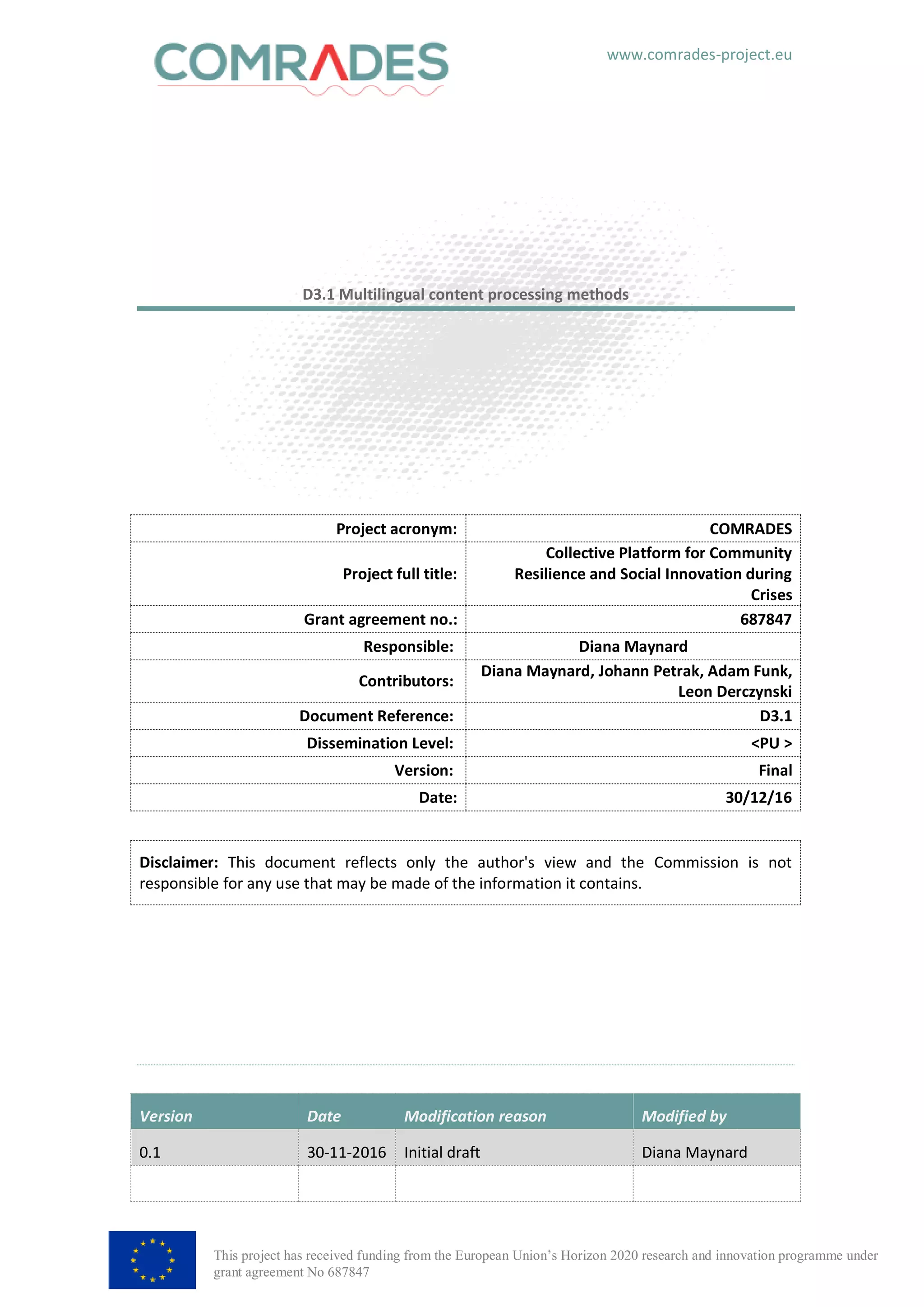

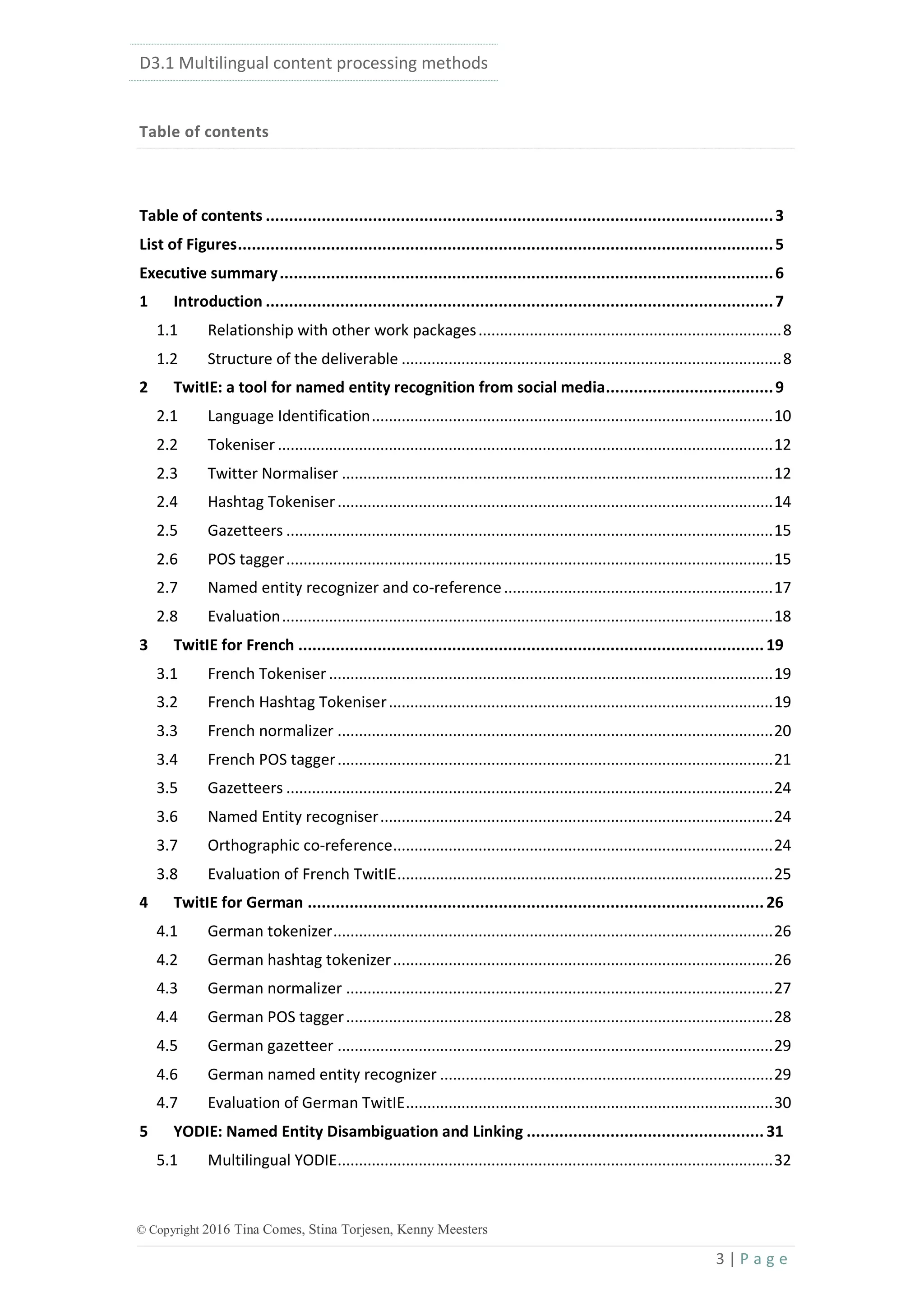
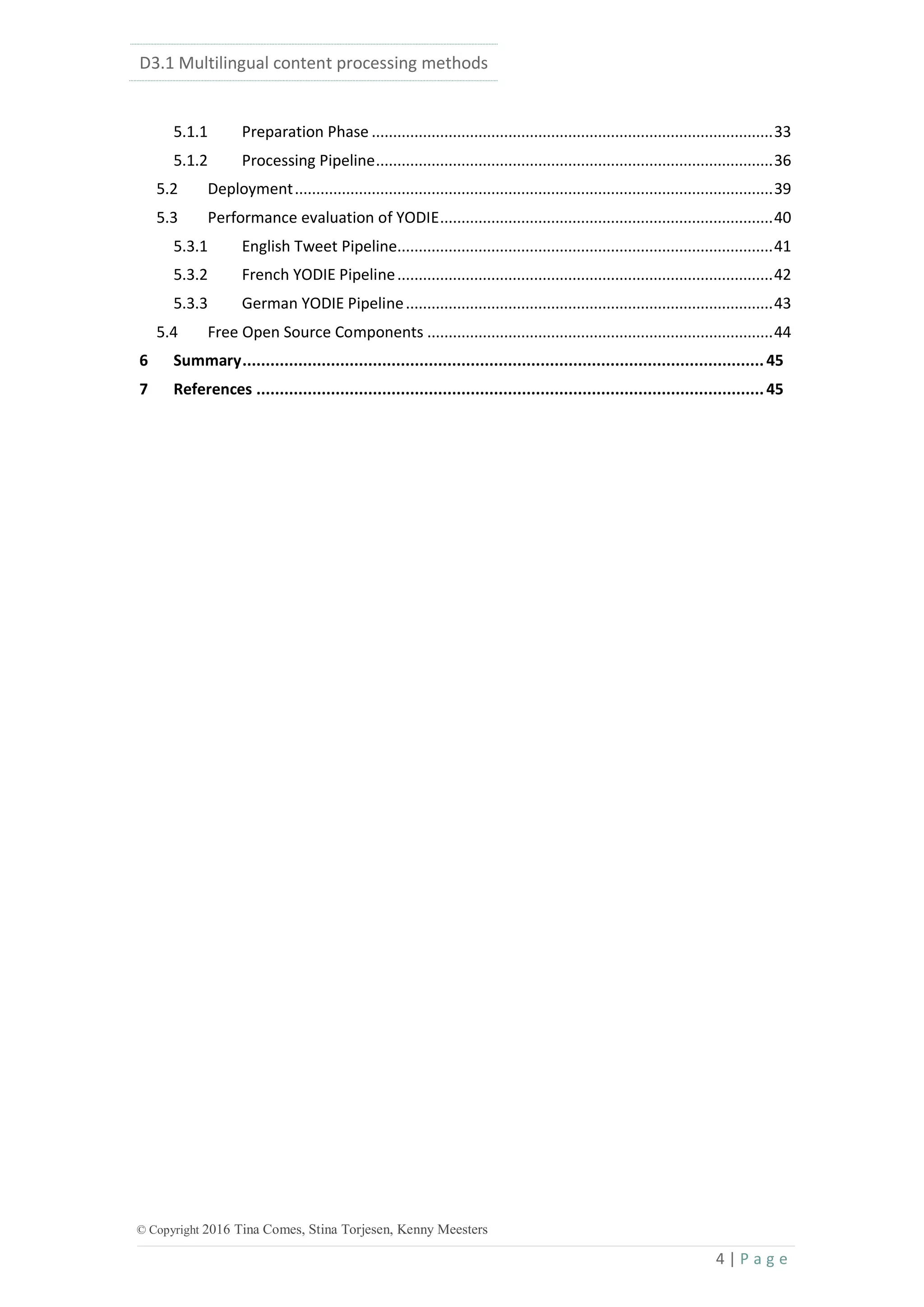
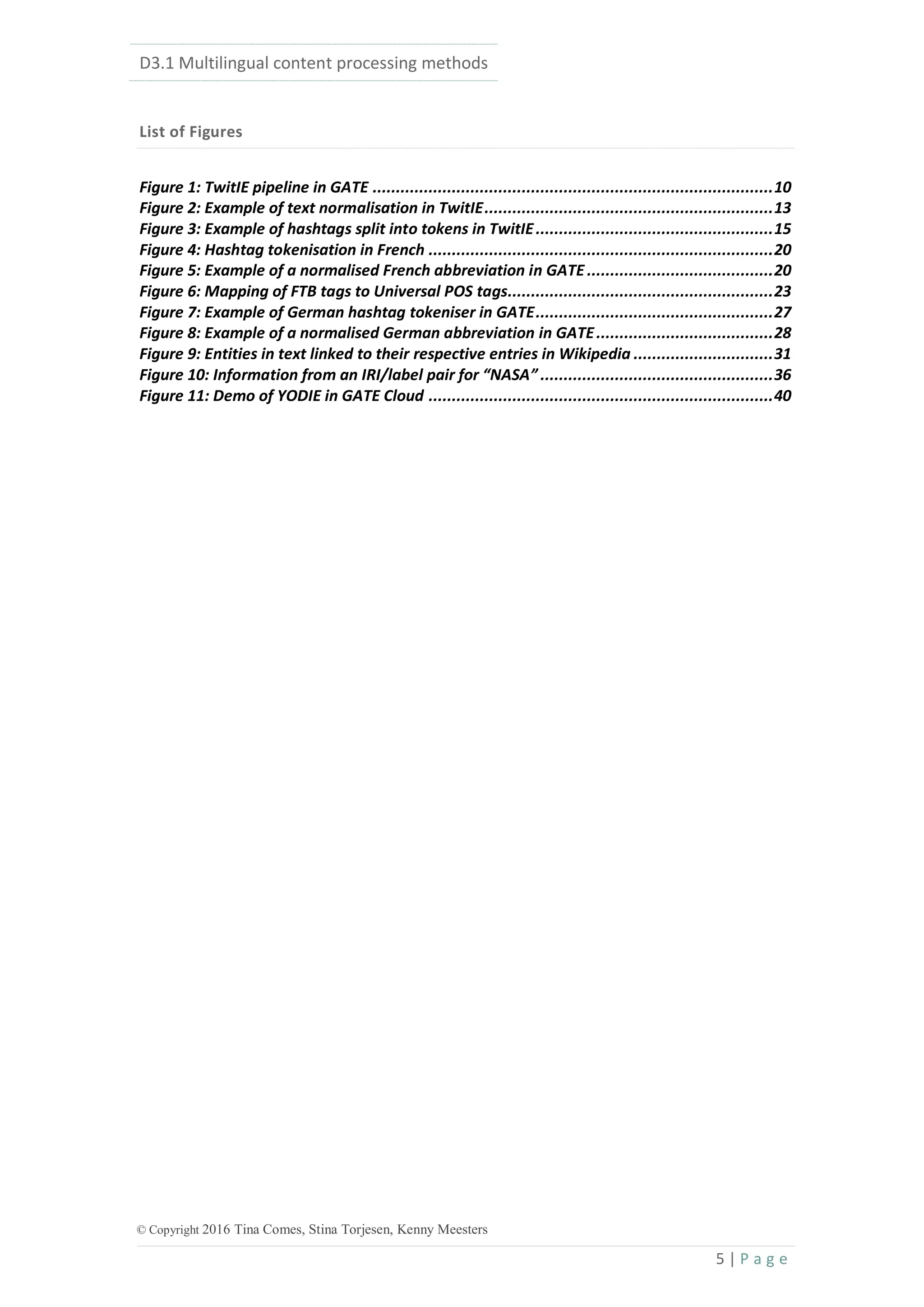
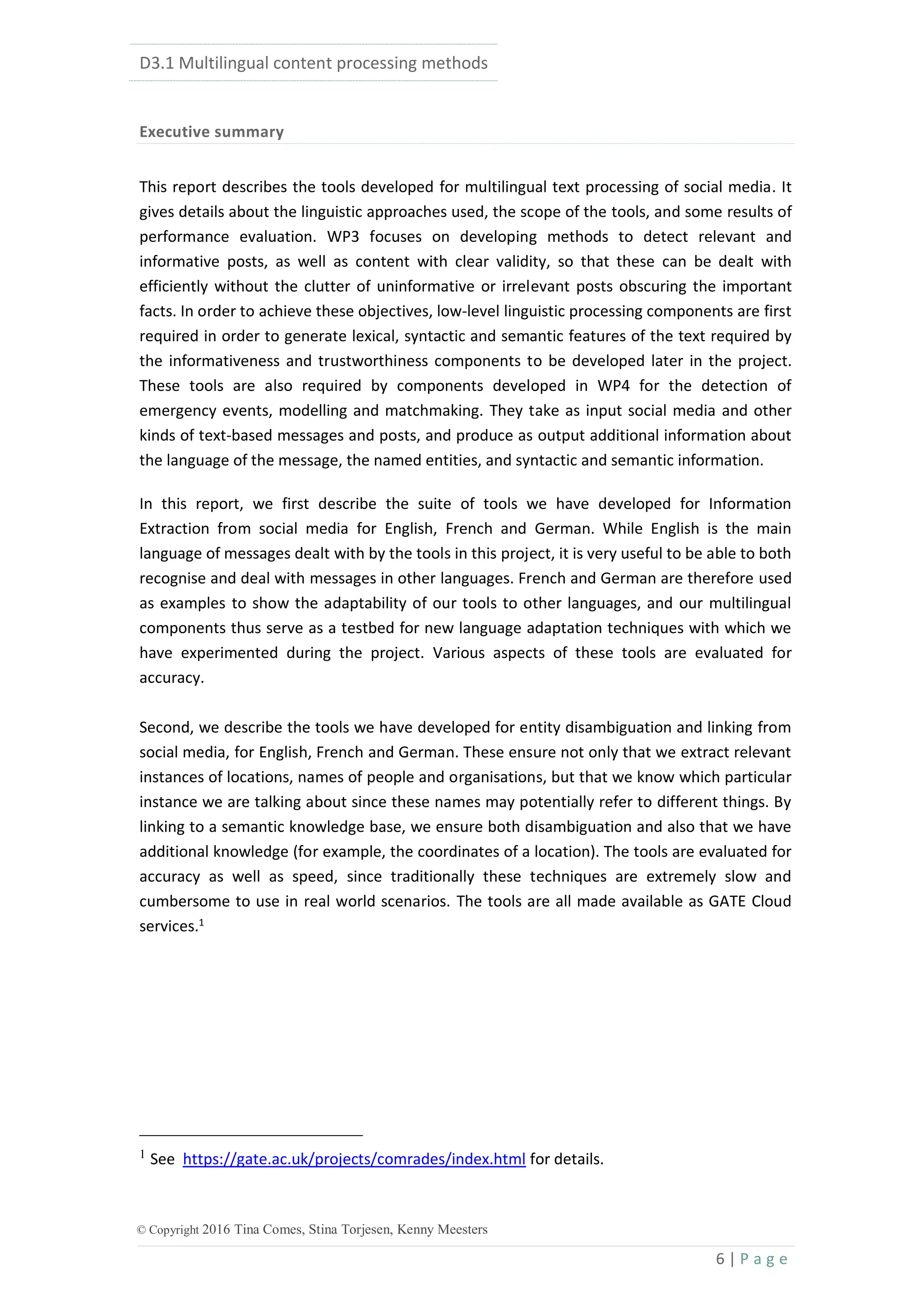
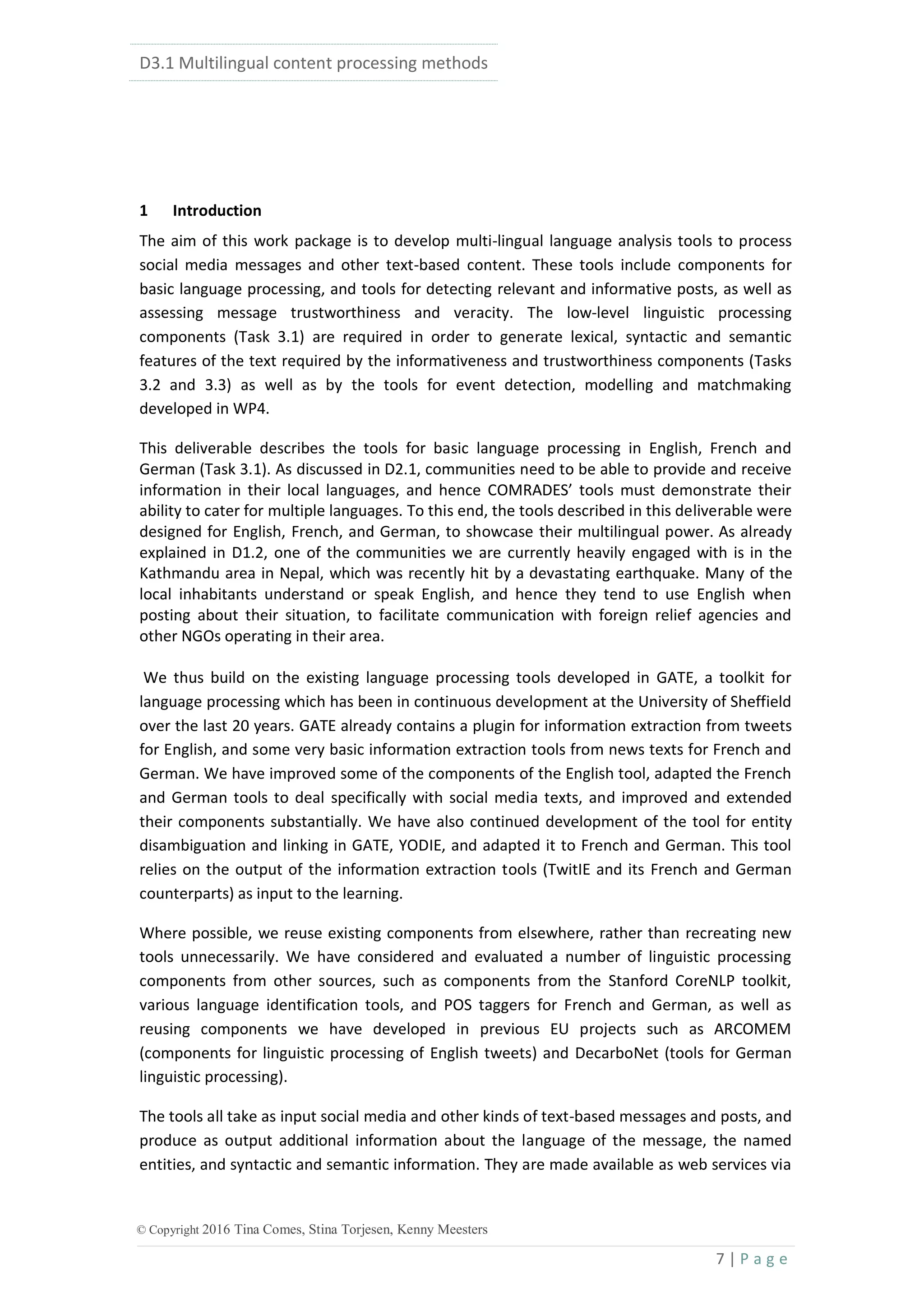
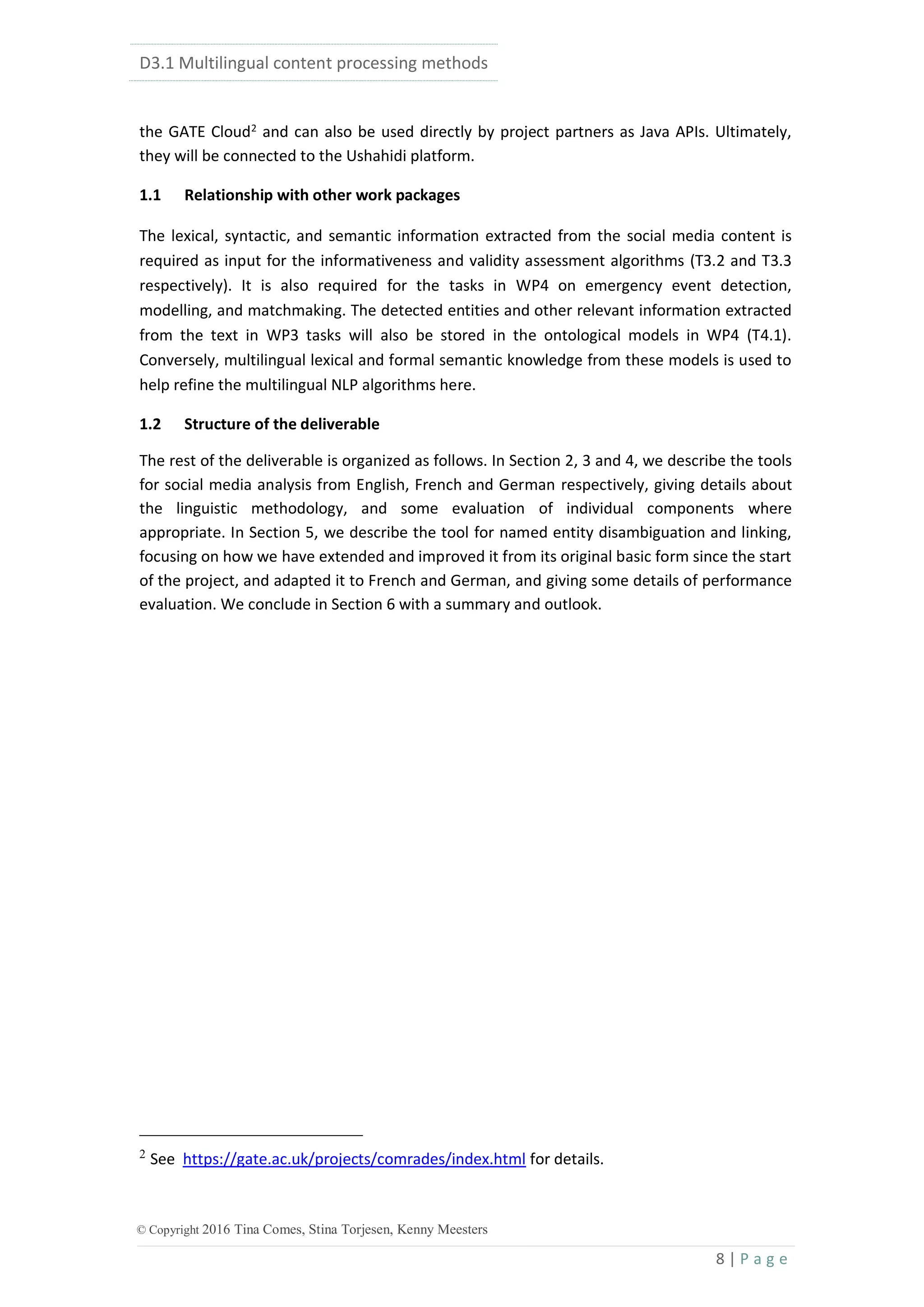

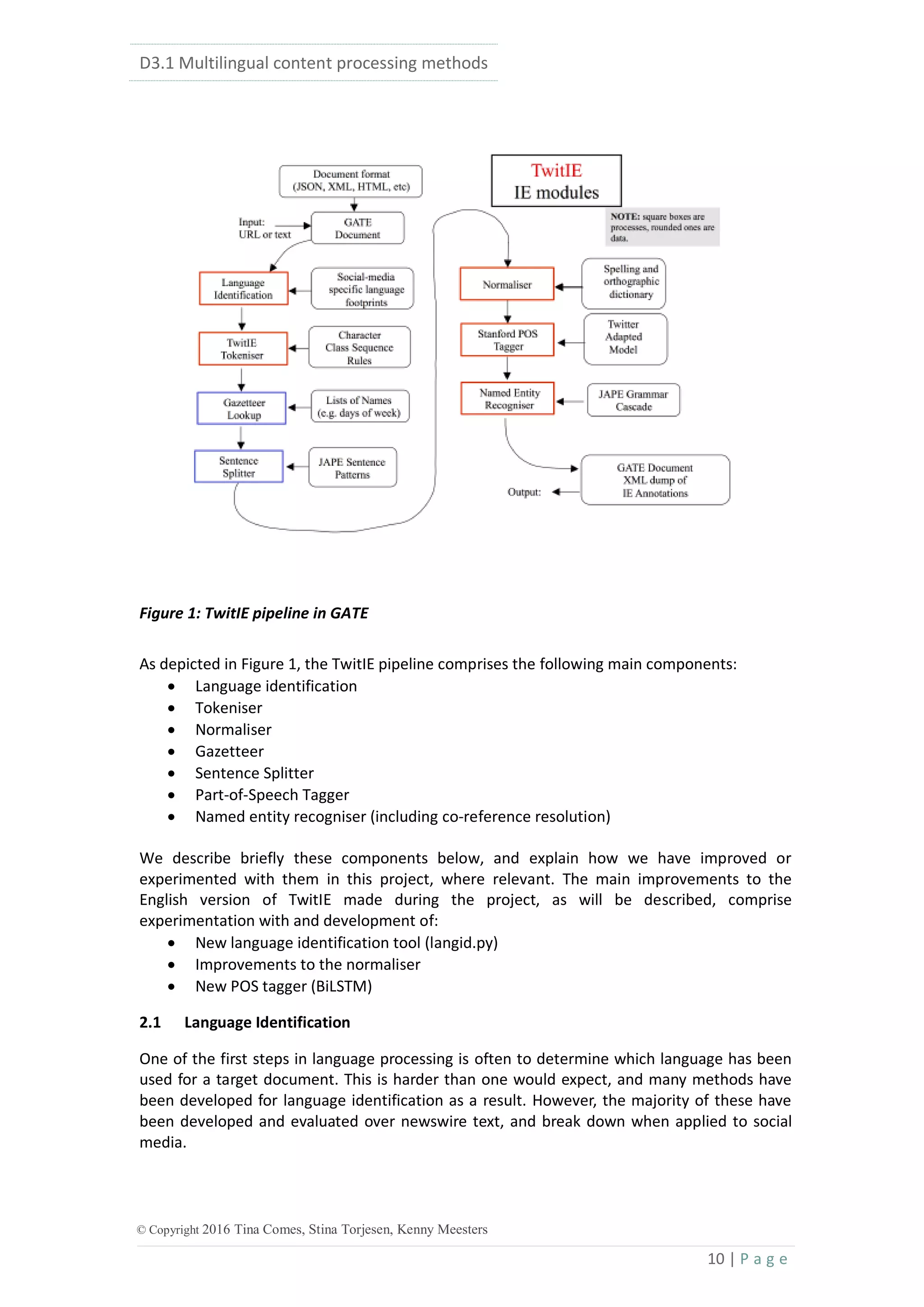
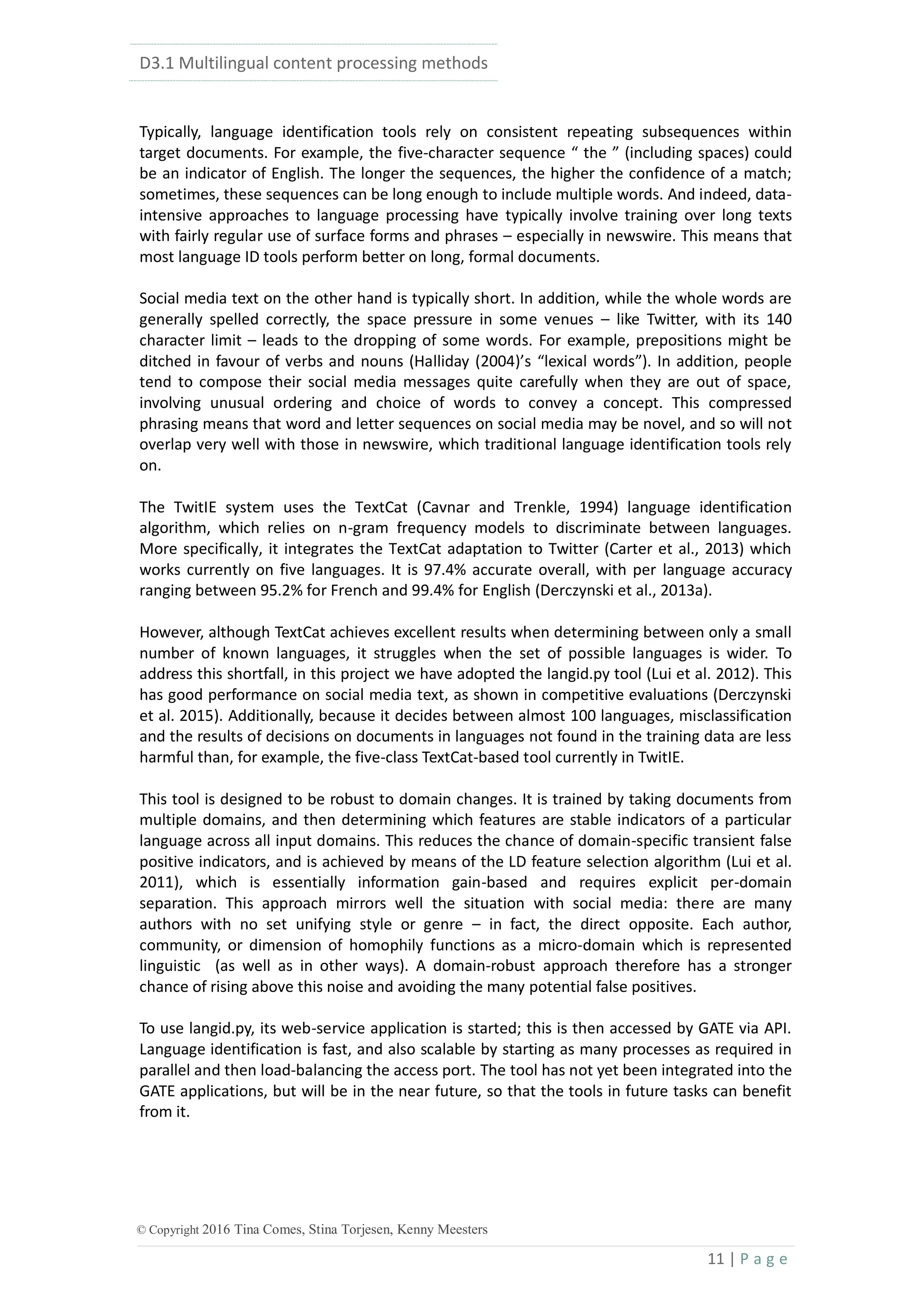
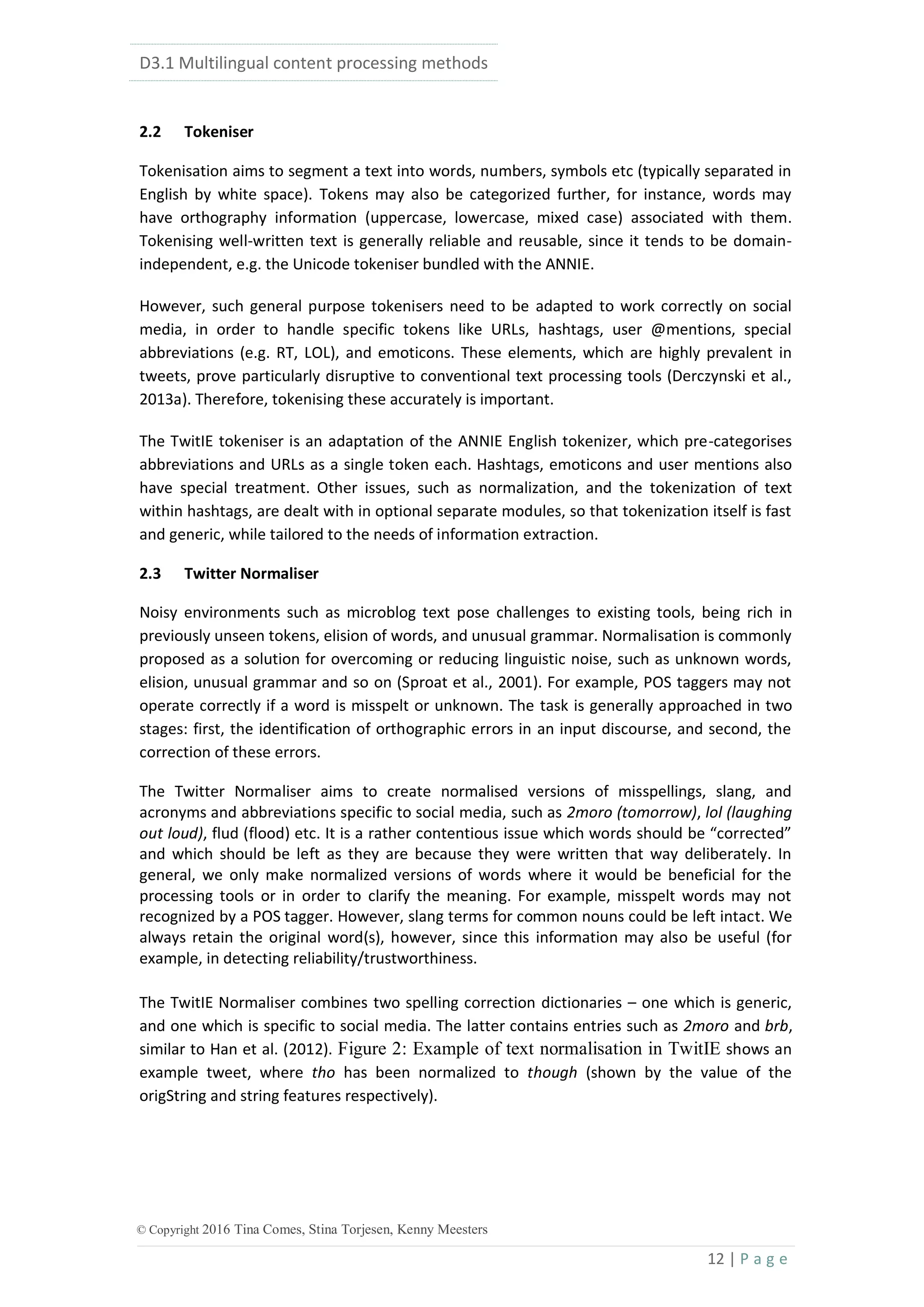
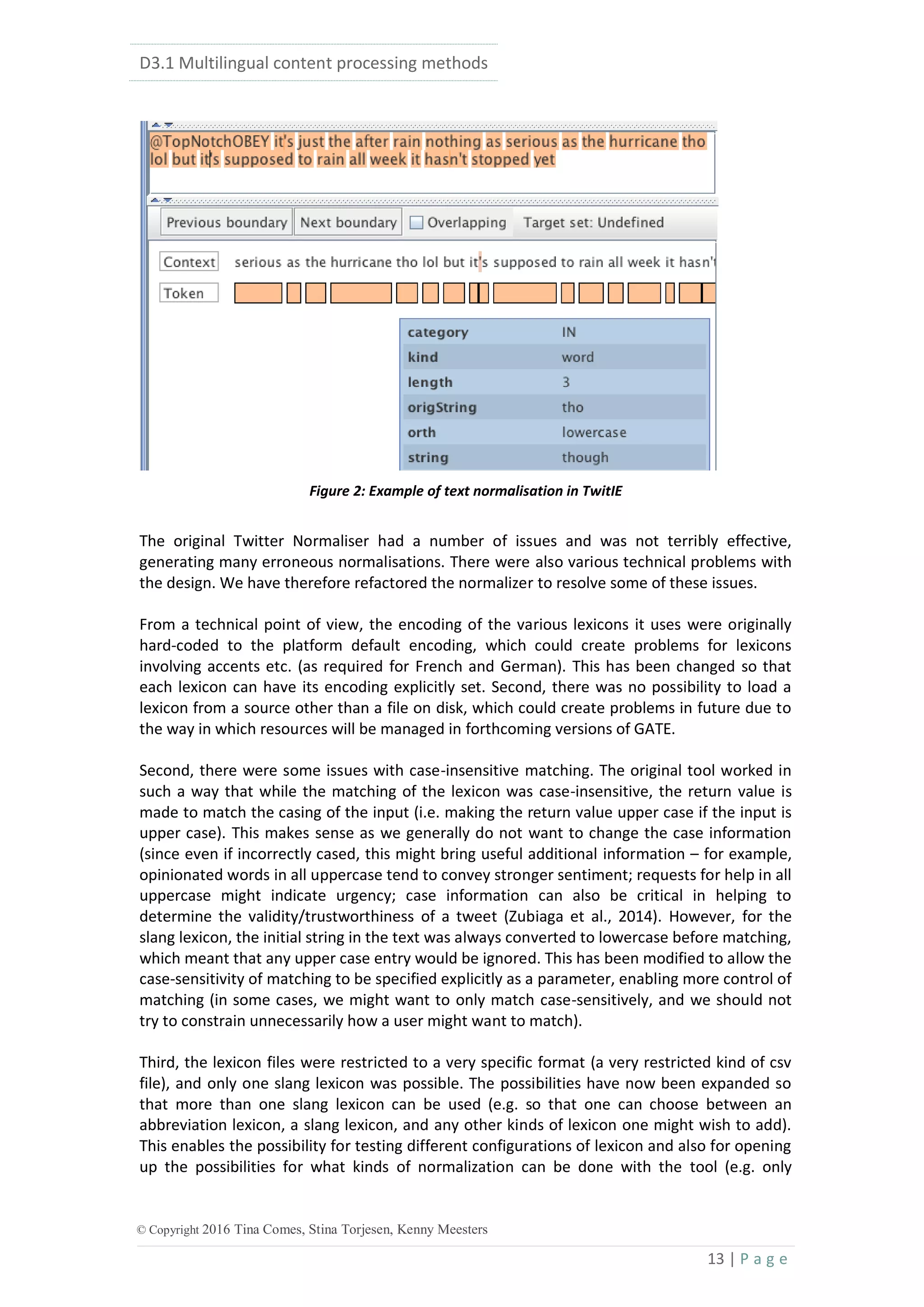
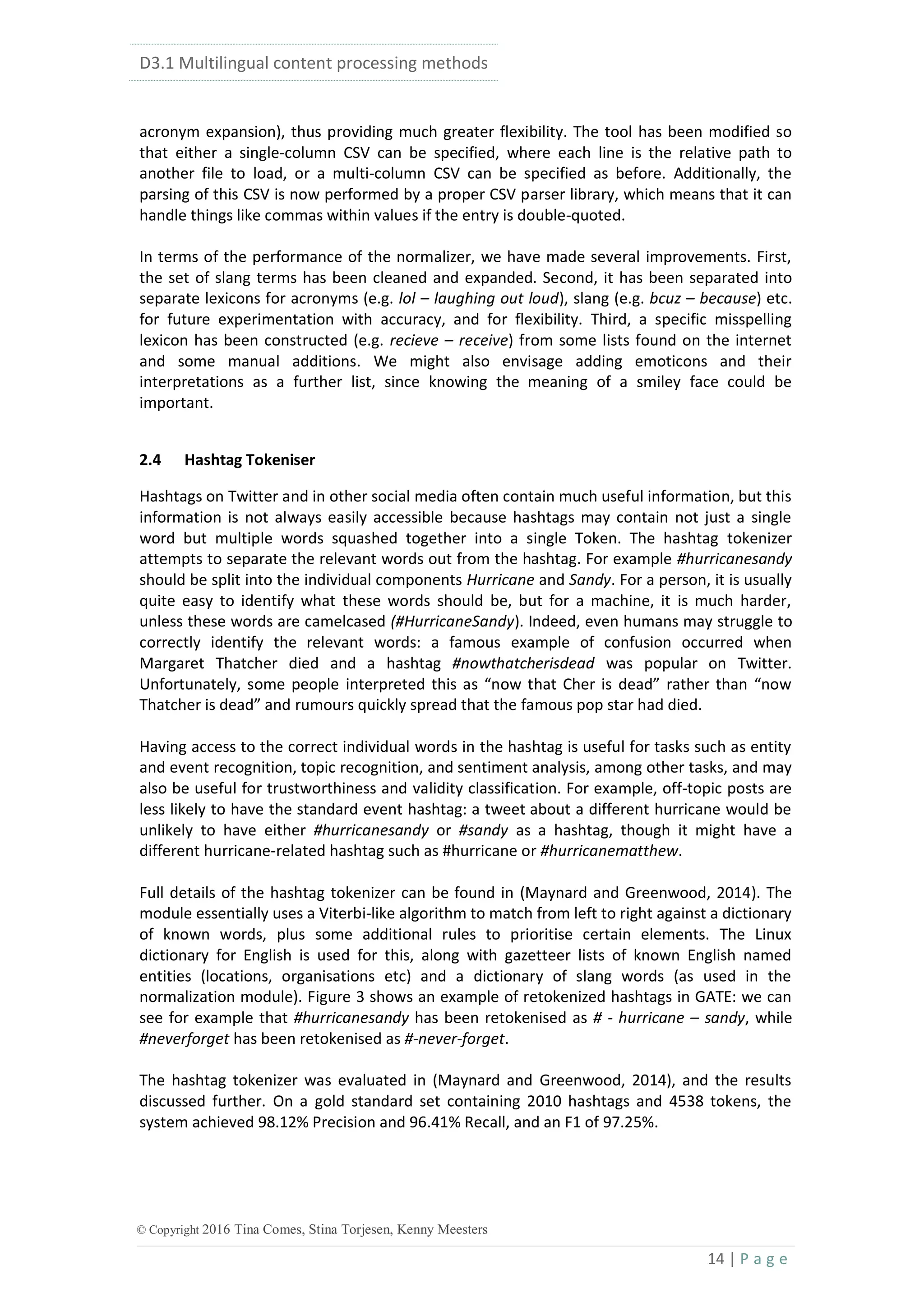


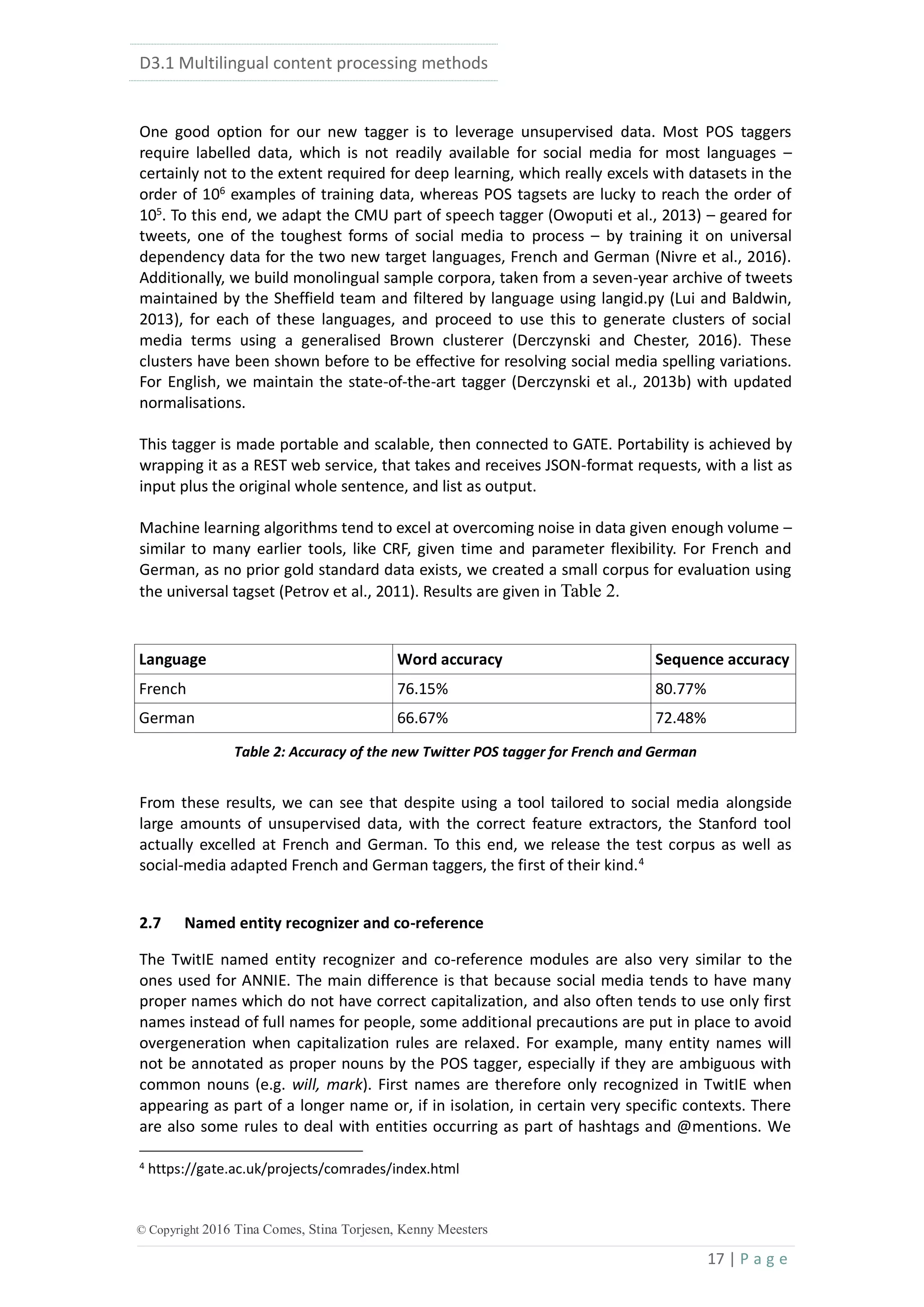




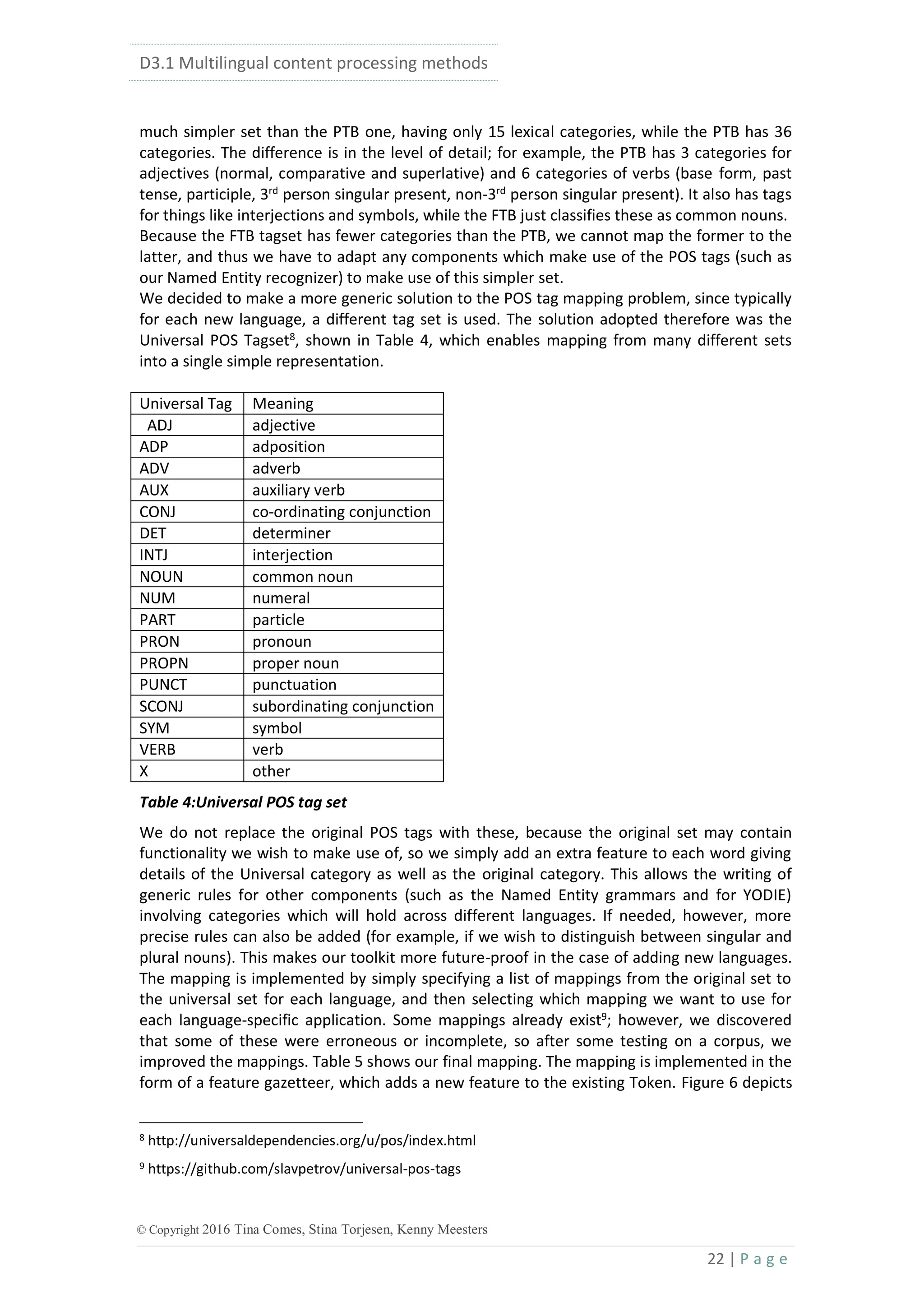
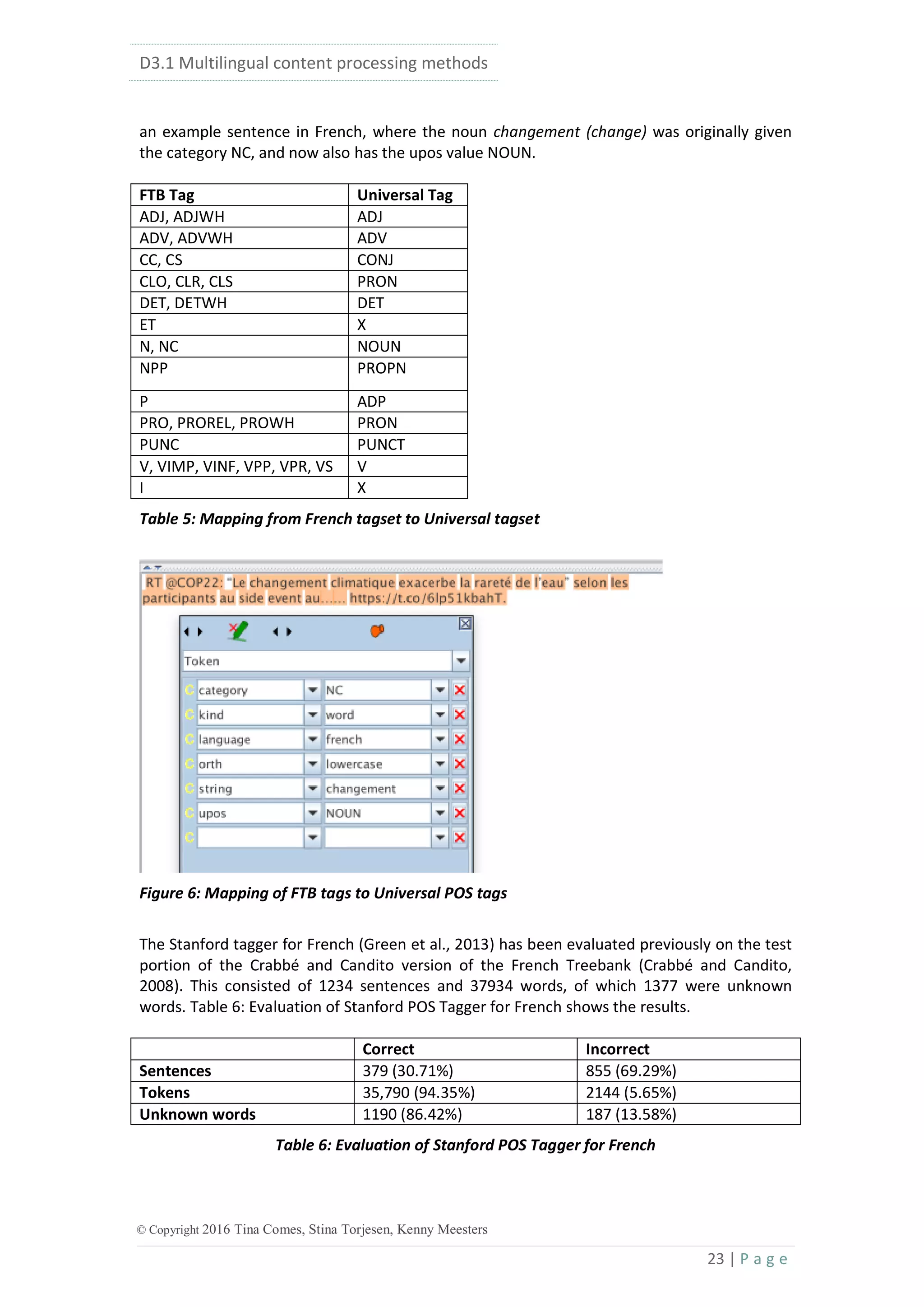
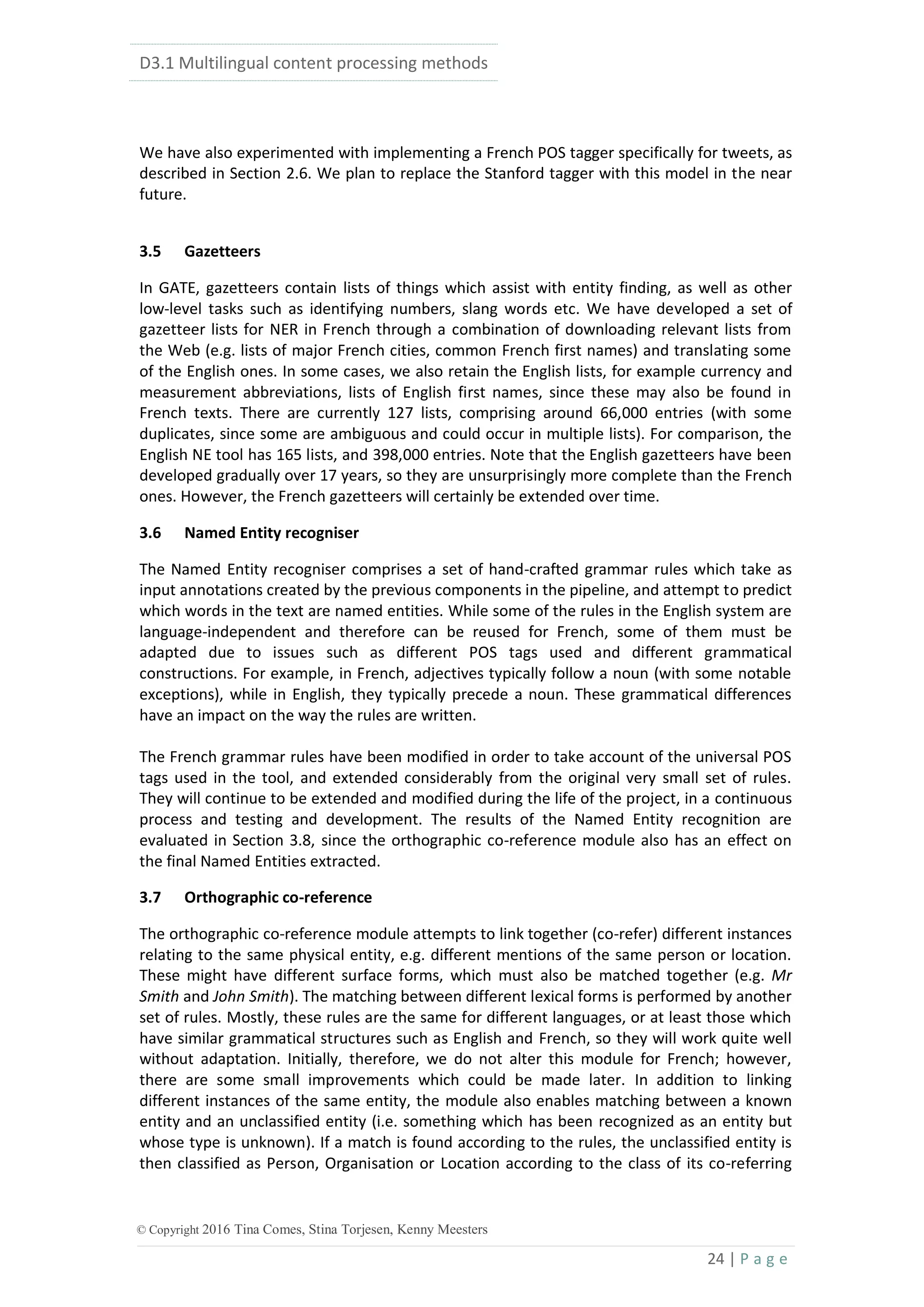
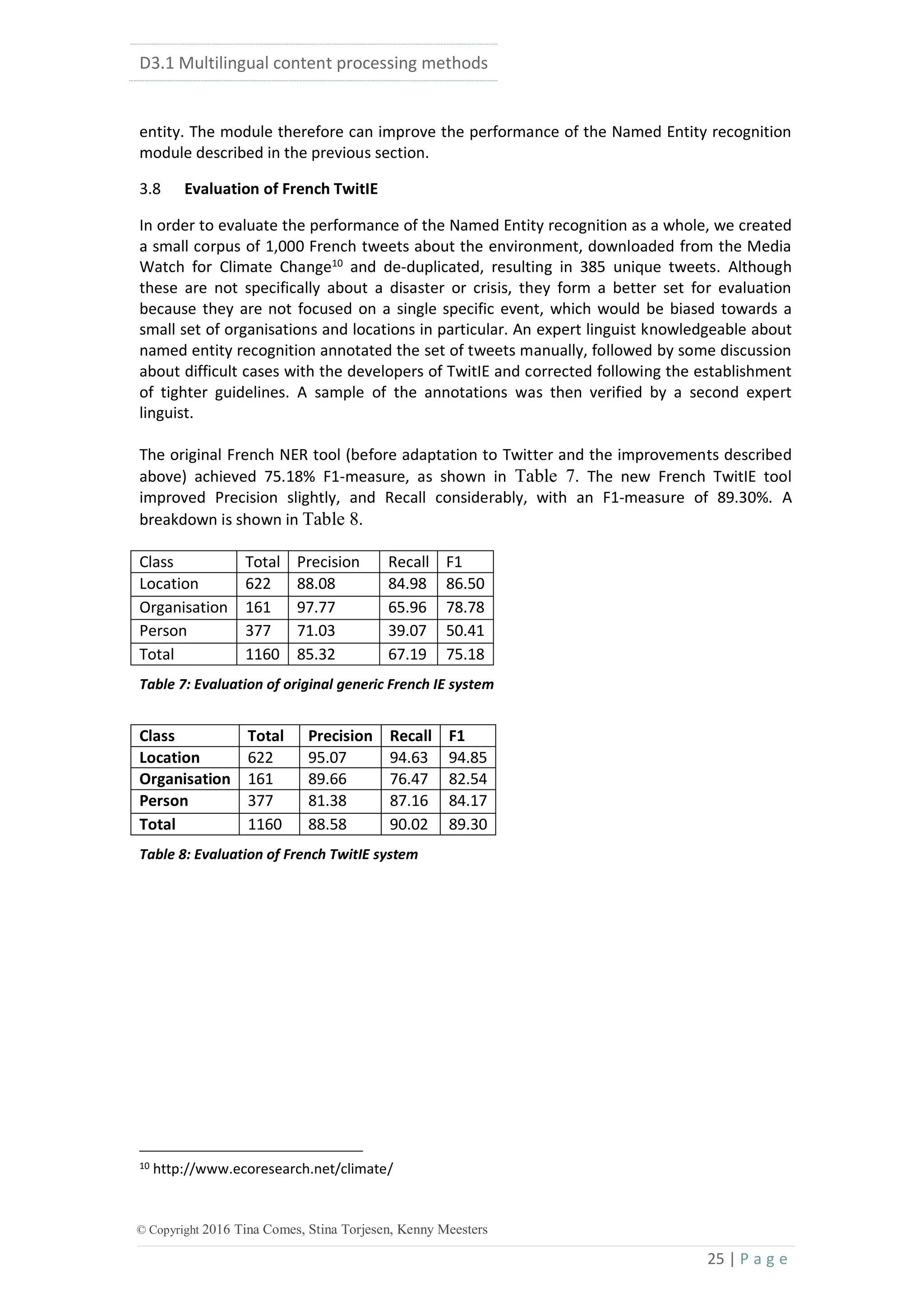
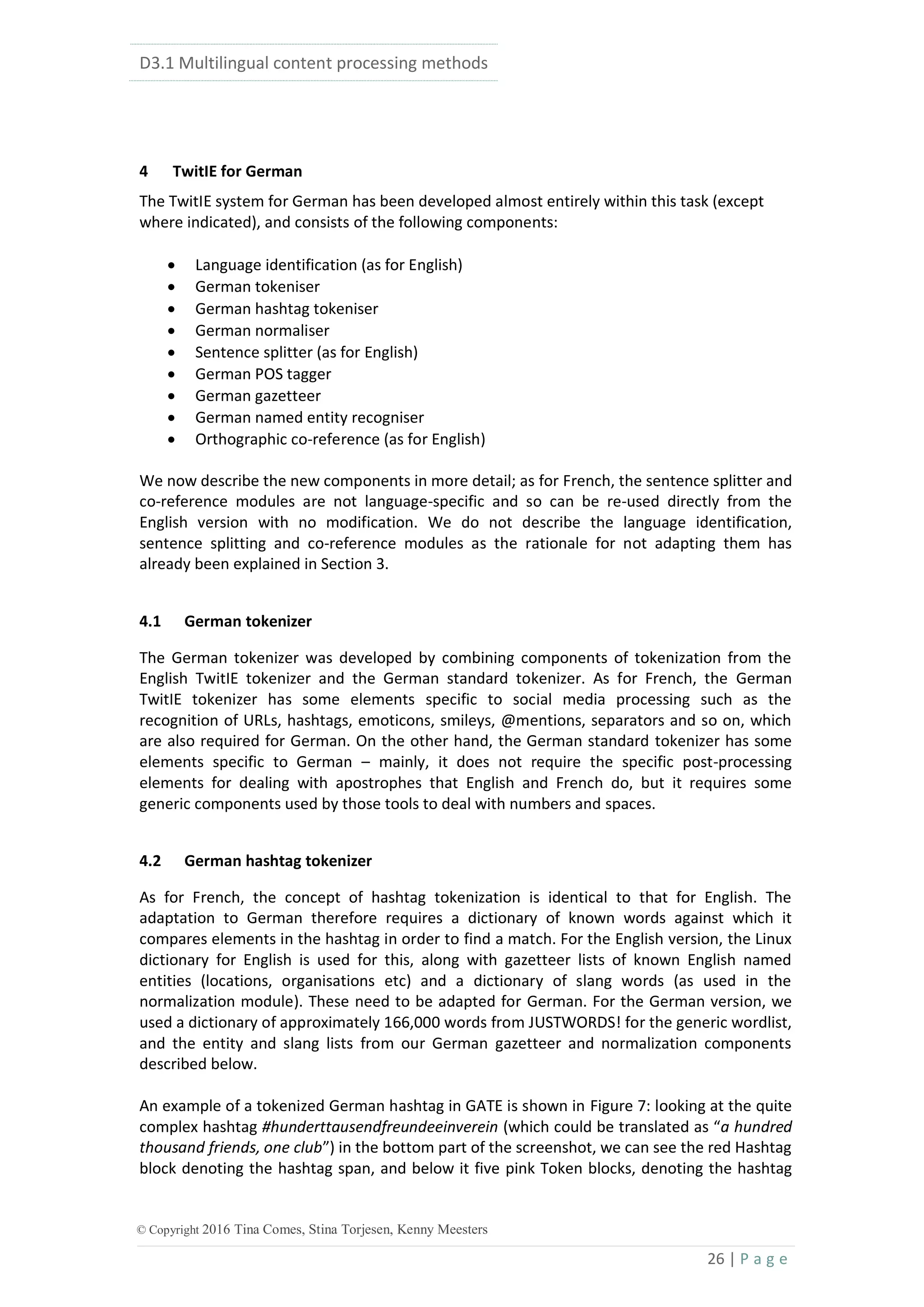
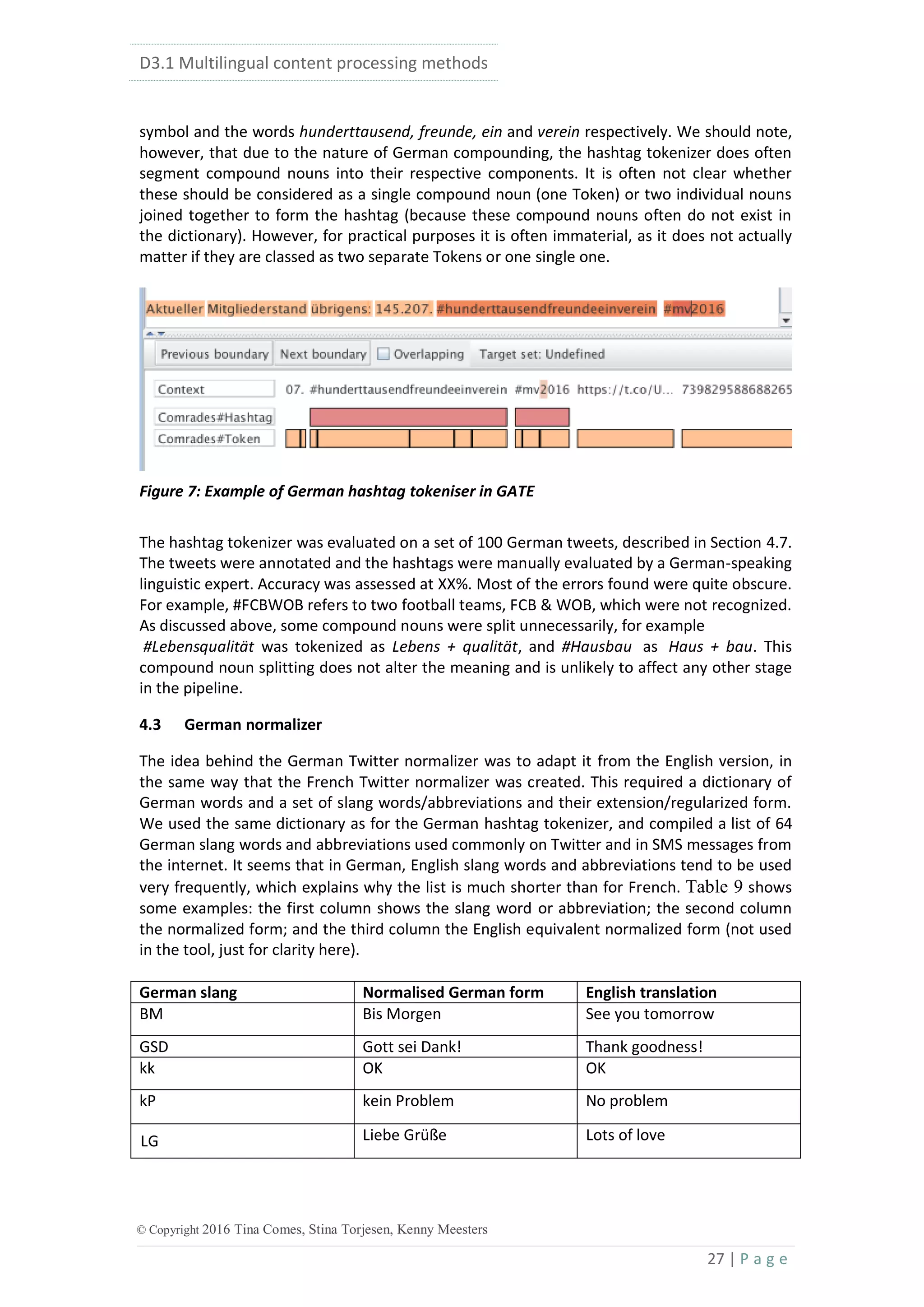
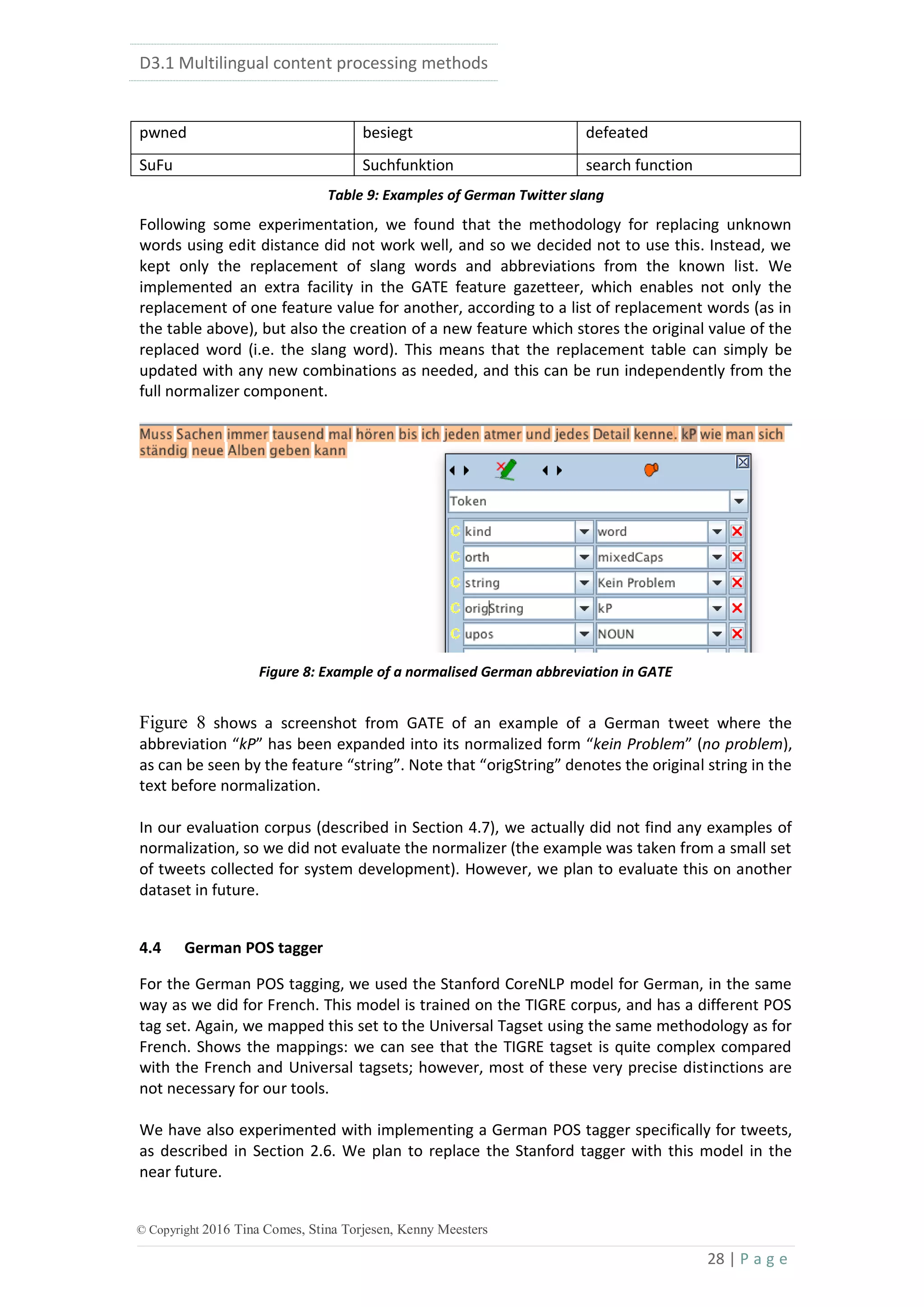
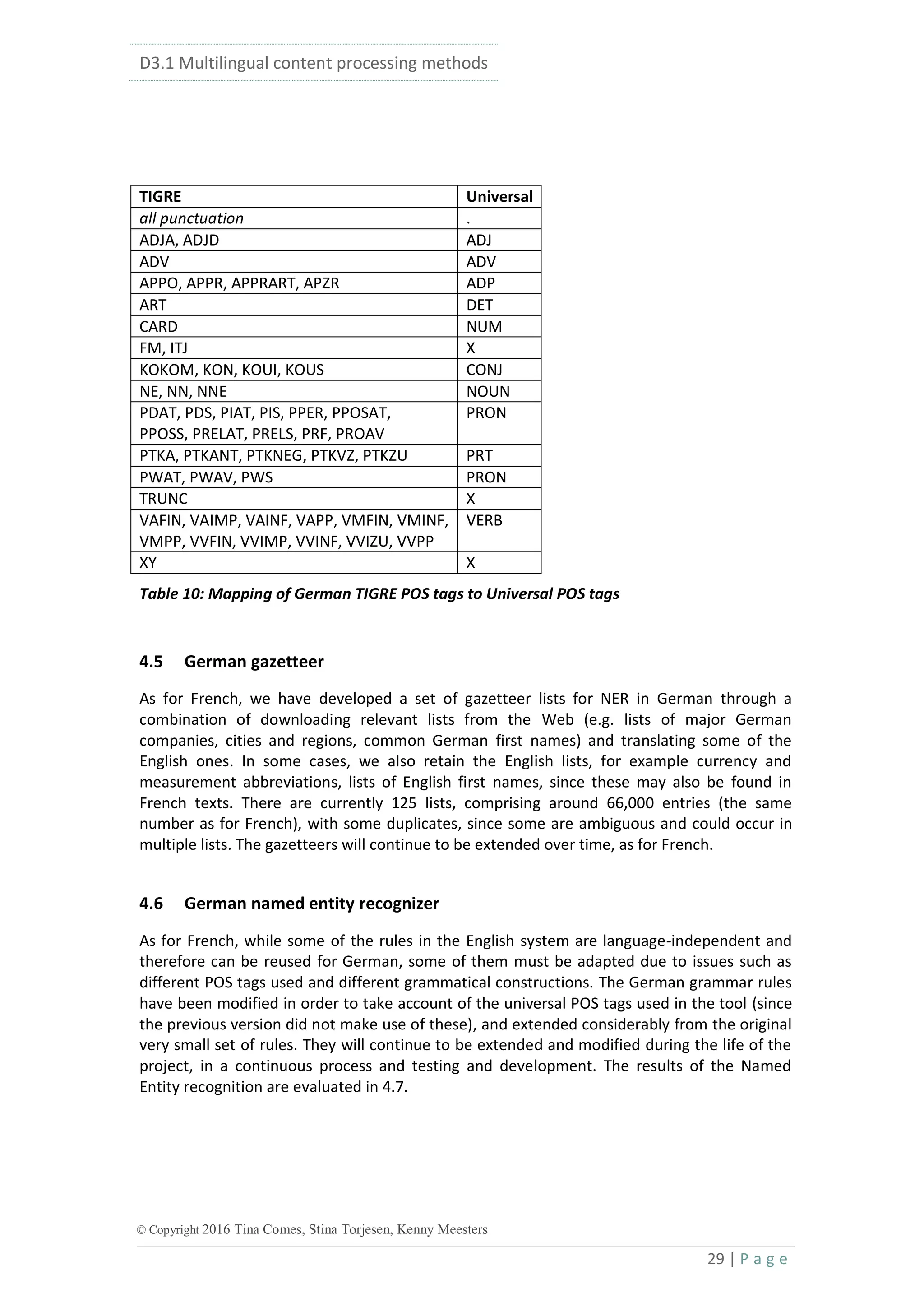
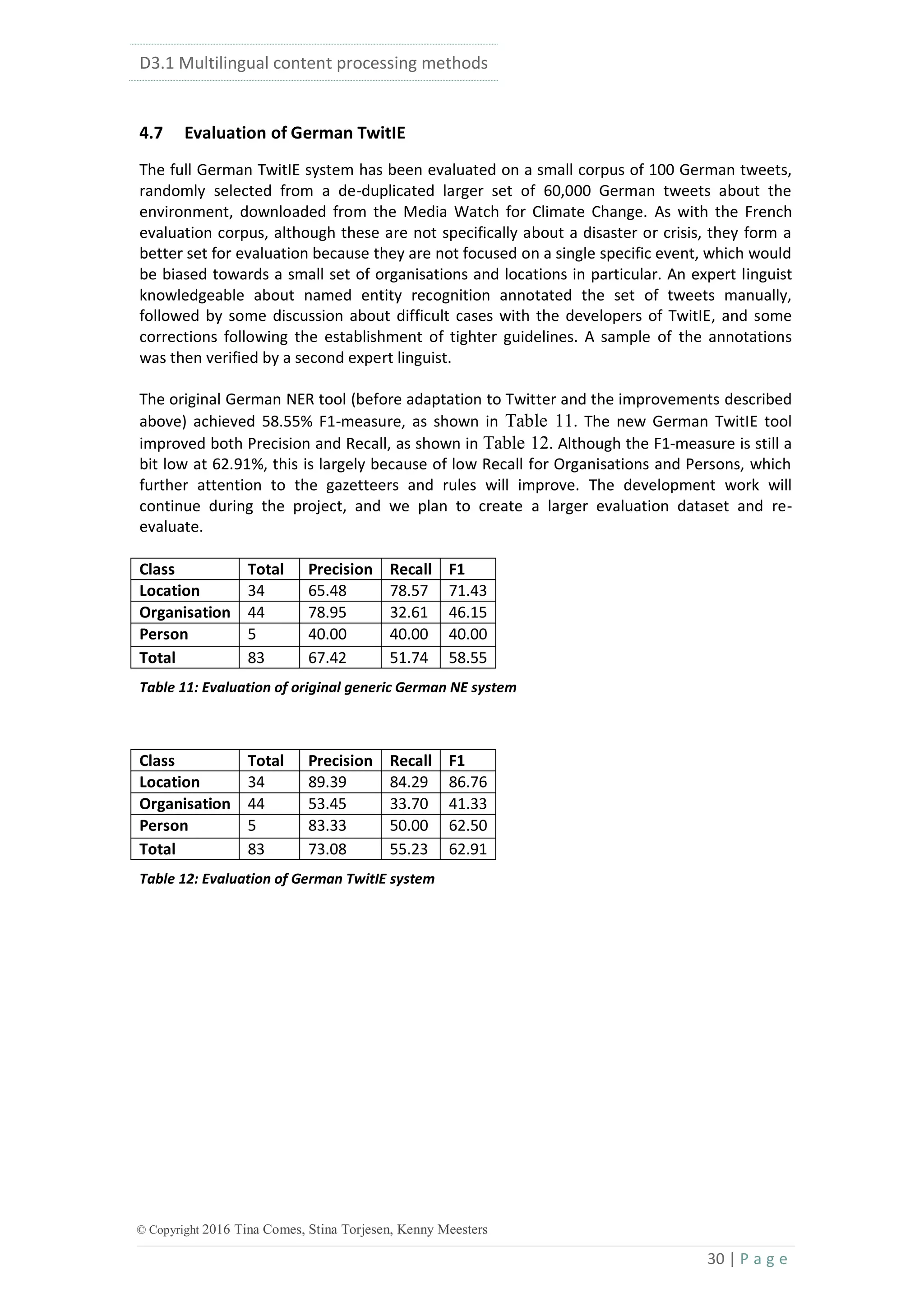
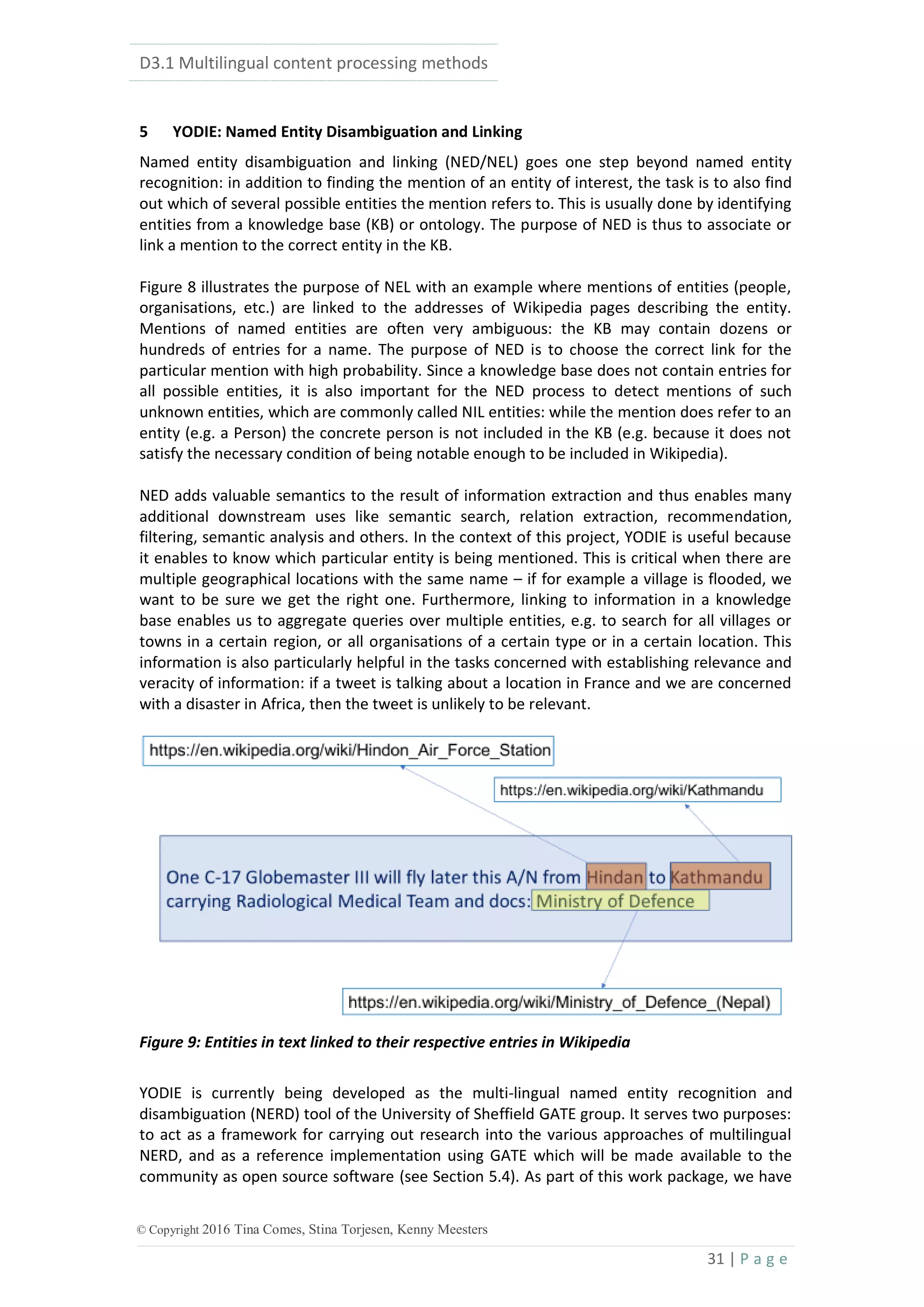
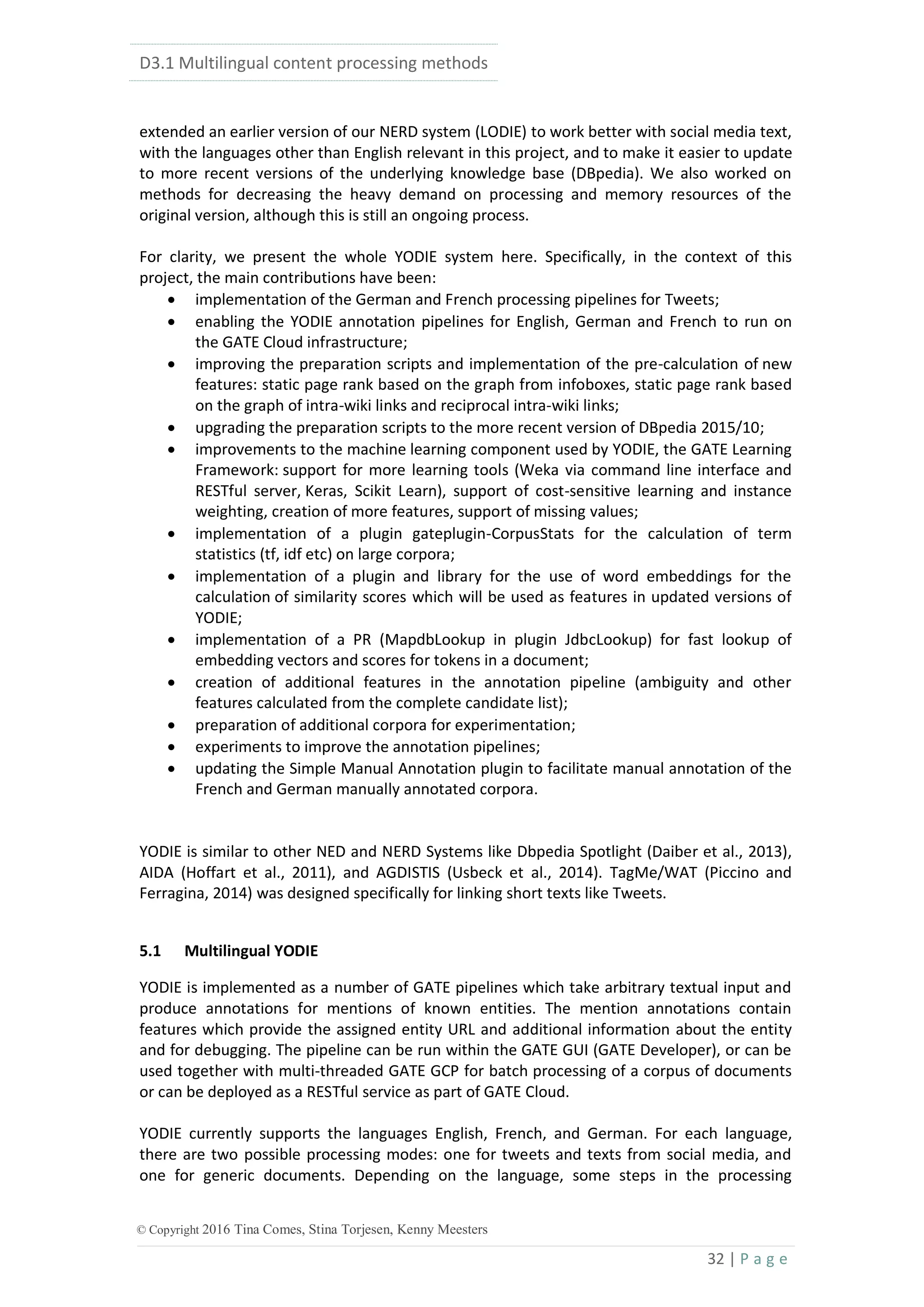
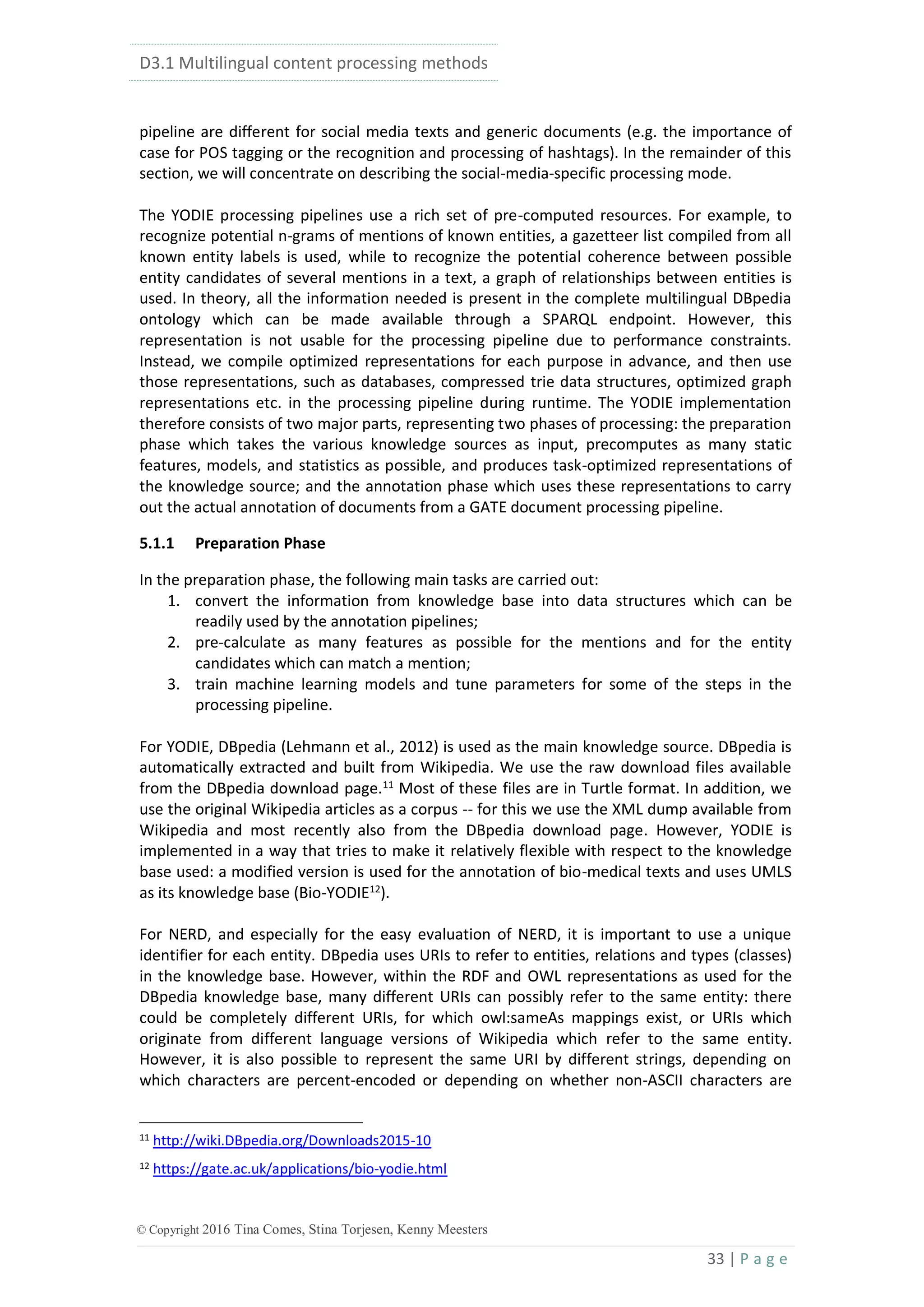
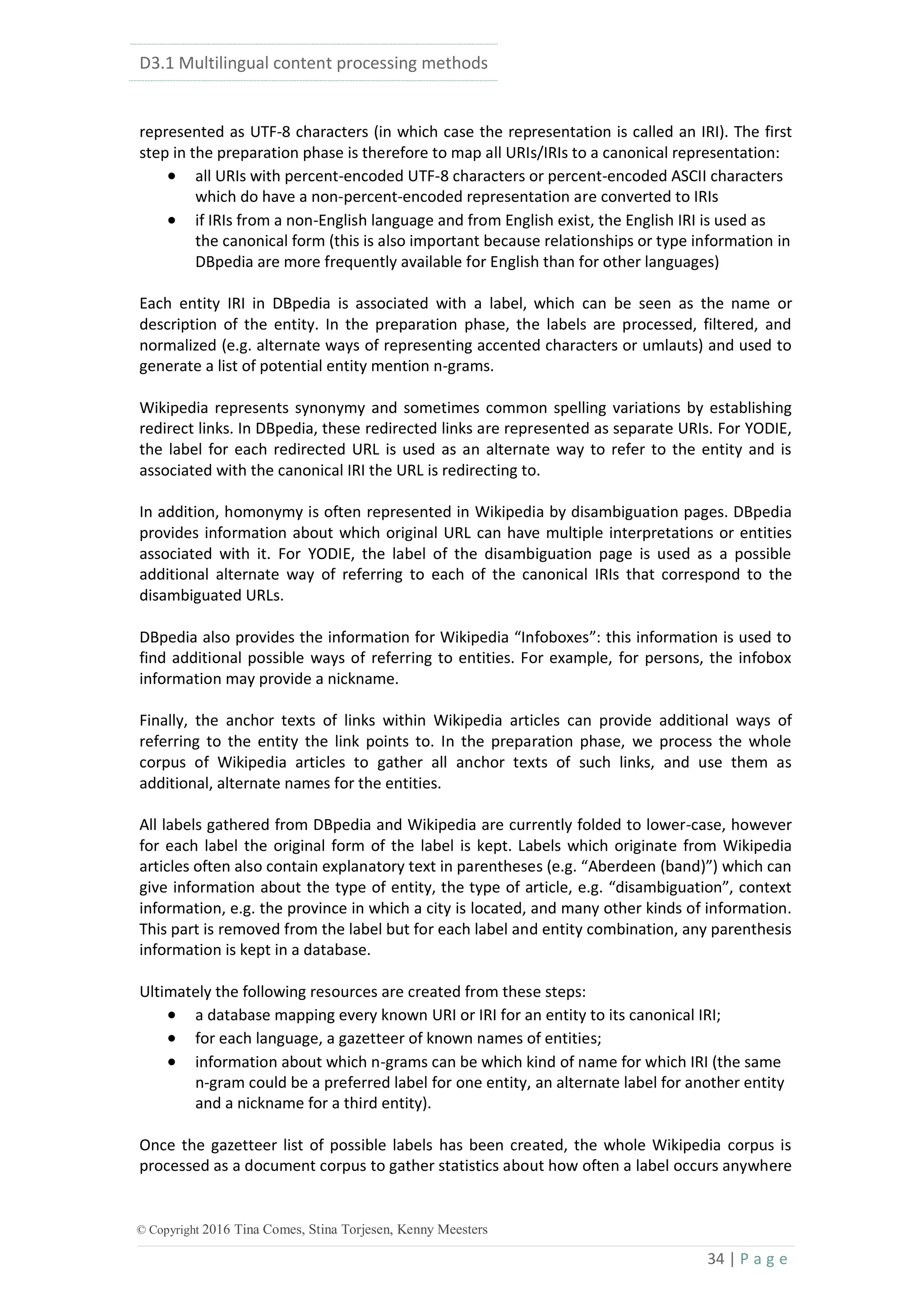
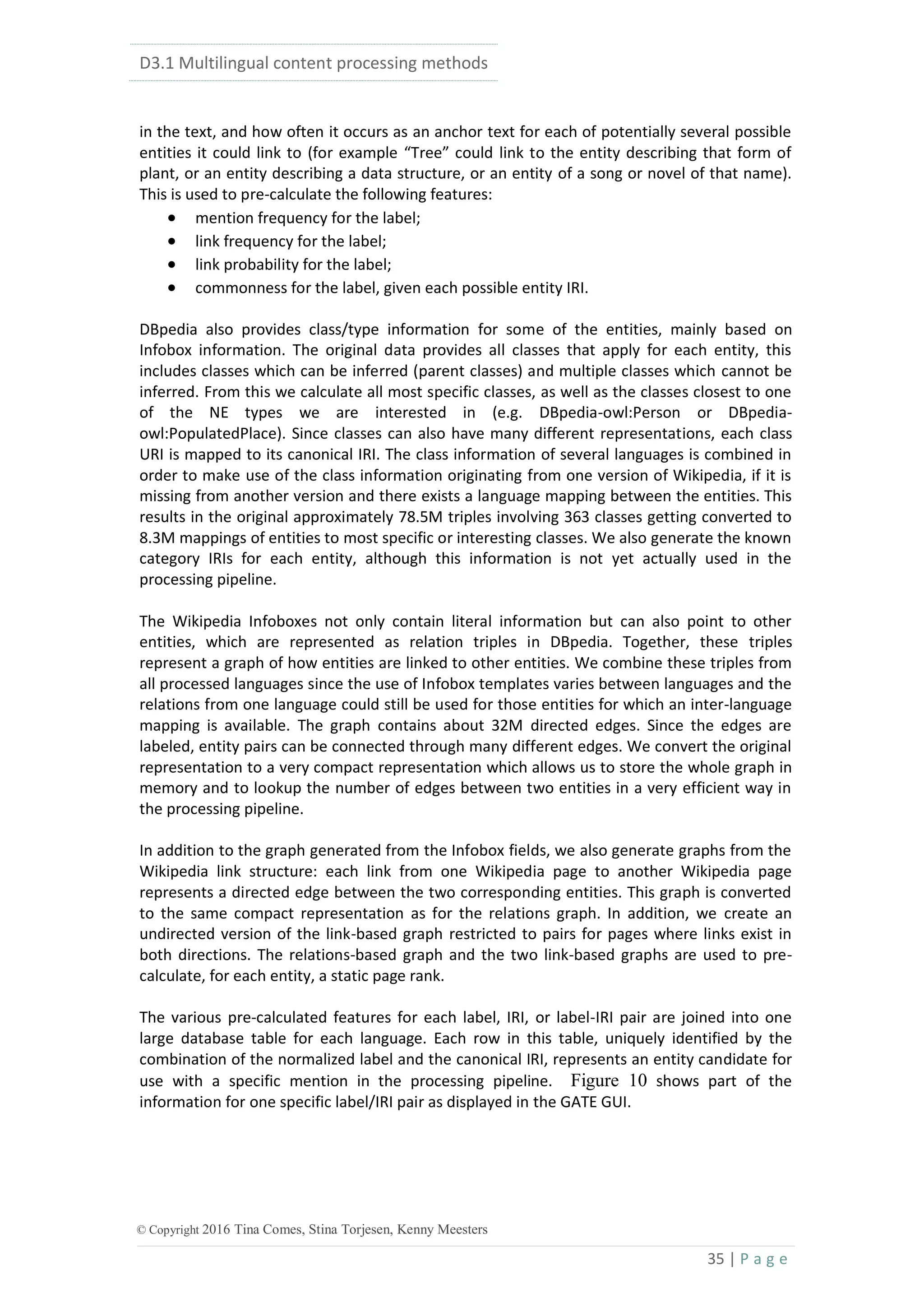
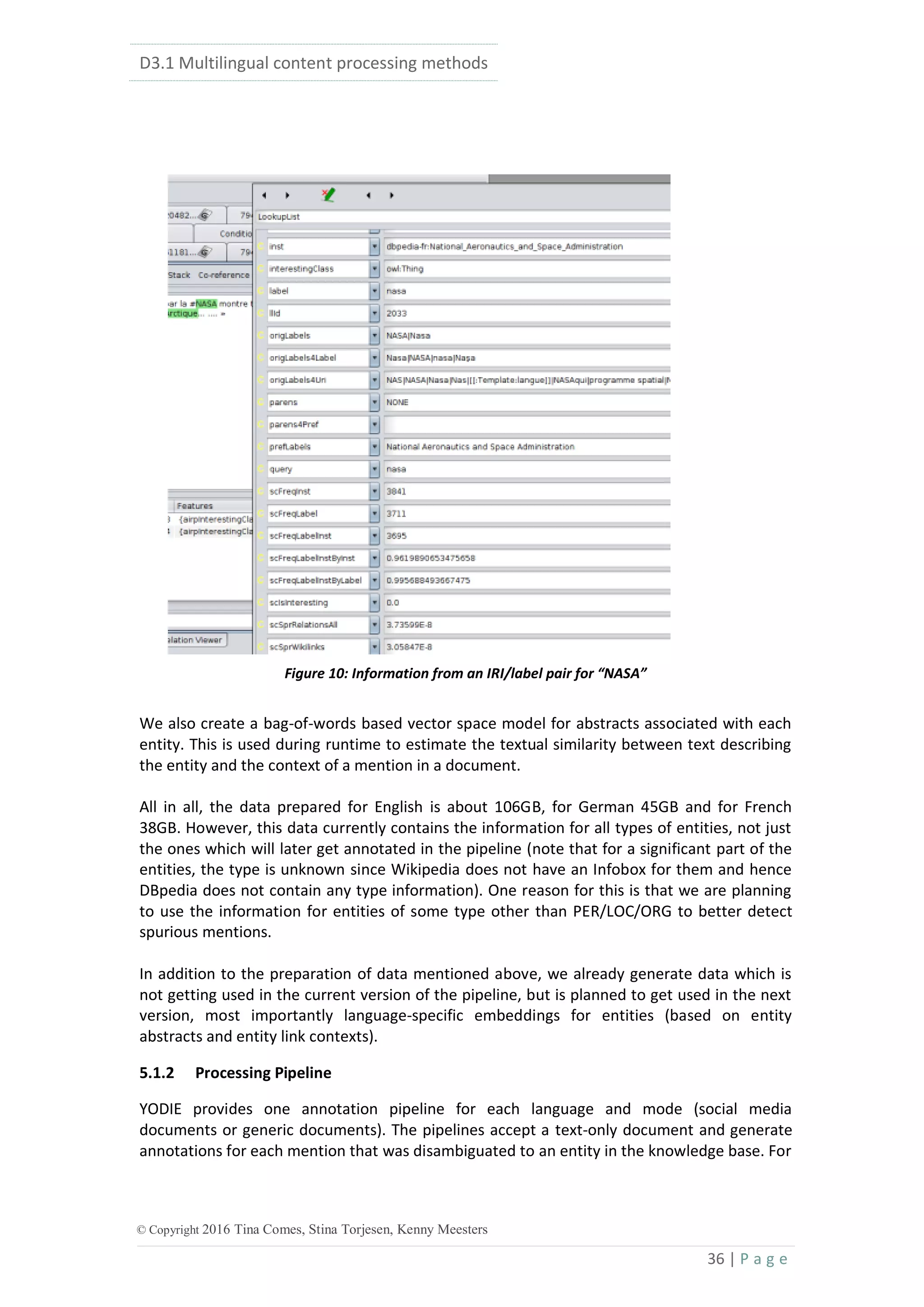
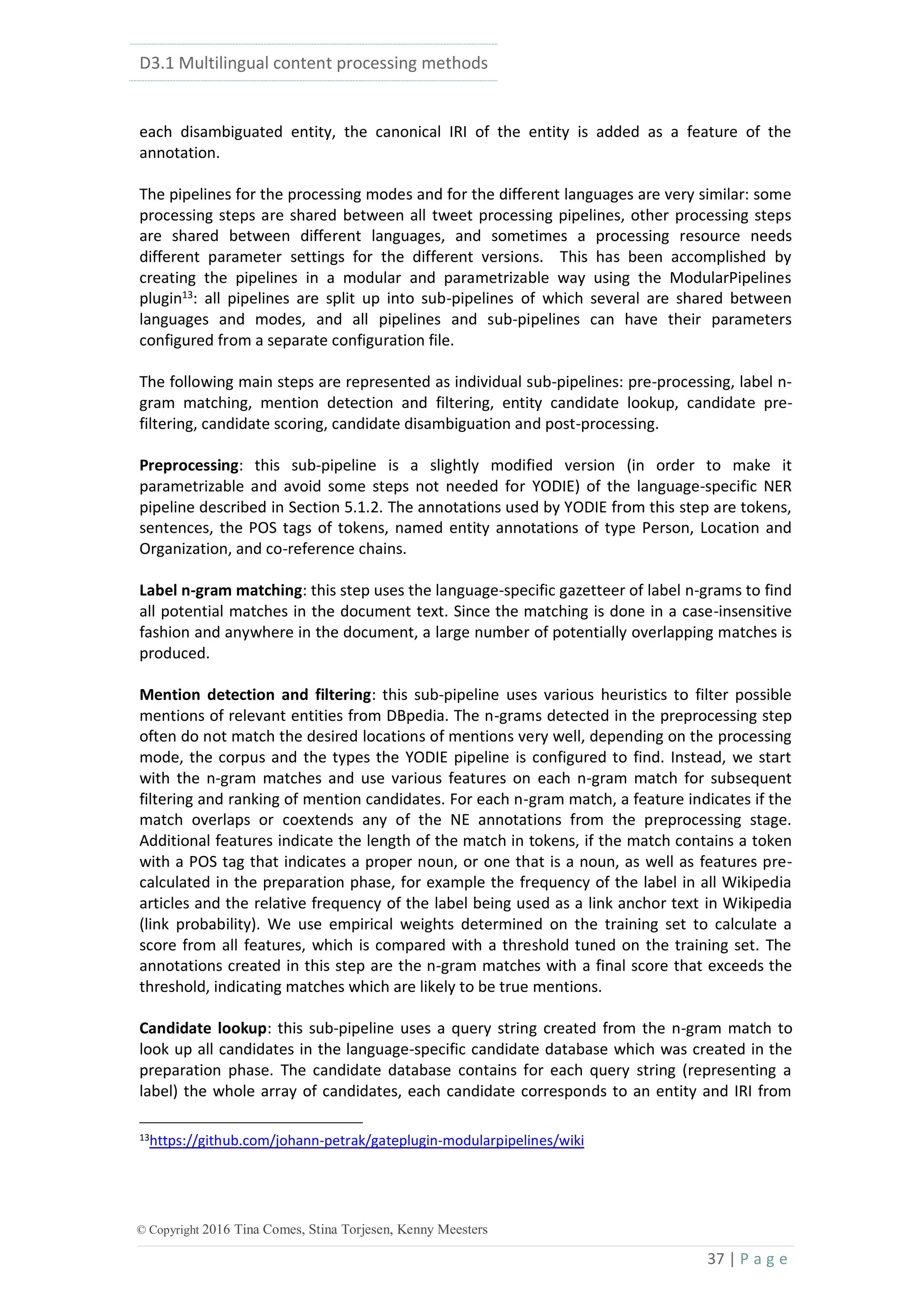
![D3.1 Multilingual content processing methods
38 | P a g e
© Copyright 2016 Tina Comes, Stina Torjesen, Kenny Meesters
the knowledge base and is represented as a map of key/value pairs representing the pre-
calculated features of that candidate. Some features contain arrays of values (for example,
entity types since an entity can belong to several DBpedia ontology classes, or the original
labels with their original spelling). In addition, a number of additional features are calculated
for the mention itself: these features reflect various aspects of the ambiguity of the mention
(e.g. the number of candidates found, the difference in commonness between the most
common and 2nd
common candidate and others).
Candidate pre-filtering: this is a highly configurable step that includes various heuristics to
reduce the number of candidates in each list of potential entity candidates for a mention. The
most important heuristics currently are:
remove candidates where the DBpedia type indicates that we are not interested, e.g.
a biological species.
Identify candidates for a label which could be an abbreviation, if followed by the full
name for the abbreviation.
Process the lists for all overlapping mentions detected for a location name of the
form “Washington, D.C.” – this uses DBpedia relations (“Washington_DC lies in D.C.”)
to limit the number of candidates which could match the full (longest) mention.
Reduce overlapping mentions: the general strategy is to use the longest span that
matches a label from Wikipedia, but this strategy sometimes produces wrong spans
or wrong entity lists: for example “The White House” is a valid label but may
incorrectly match “in [the White House]”. We reduce the span for mentions that
include determiners or possessive constructs.
Finally, the candidate list is sorted by a score that reflects the likelihood of the
candidate being a valid match (currently commonness is used) and only the
candidates with the best N scores are kept. N has been tuned in previous experiments
on the training corpora (which included mostly generic documents) and set to 5, this
will get re-tuned for Twitter corpora.
Candidate scoring: Each candidate at this point already has a large number of pre-calculated
features: some from the preparation stage, some inherited from features of the mention
annotation (created in the mention detection and filtering stage) and some representing the
ambiguity of the mention (created in the candidate lookup stage). In this stage, additional
features are calculated to reflect two aspects of how well the candidate may fit the mention:
similarity to the text surrounding the mention, and similarity to other potential candidates in
the vicinity of the mention (coherence). We calculate several features for either aspect:
1. Cosine similarity of the context words with the DBpedia abstract of the candidate,
based on the bag-of-words vector space model created in the preparation phase;
2. Cosine similarity of the context words with the DBpedia literals from any infobox
properties of the entity;
3. Four scores calculated from the relationships that exist between the candidate and
candidates for other mentions in the context. These scores are based on the number
of different relationships that exist directly between two candidates or indirectly with
any single entity in between. Since the relations are directed, we use three ways of
how the current entity candidate c can be related to the other candidate o via some
additional entity a:
i. c→a→o or c←a←o (path)
ii. c←a→o (child)
iii. c→a←o (parent)](https://image.slidesharecdn.com/d3-171124135548/75/D3-1-Multilingual-content-processing-methods-38-2048.jpg)
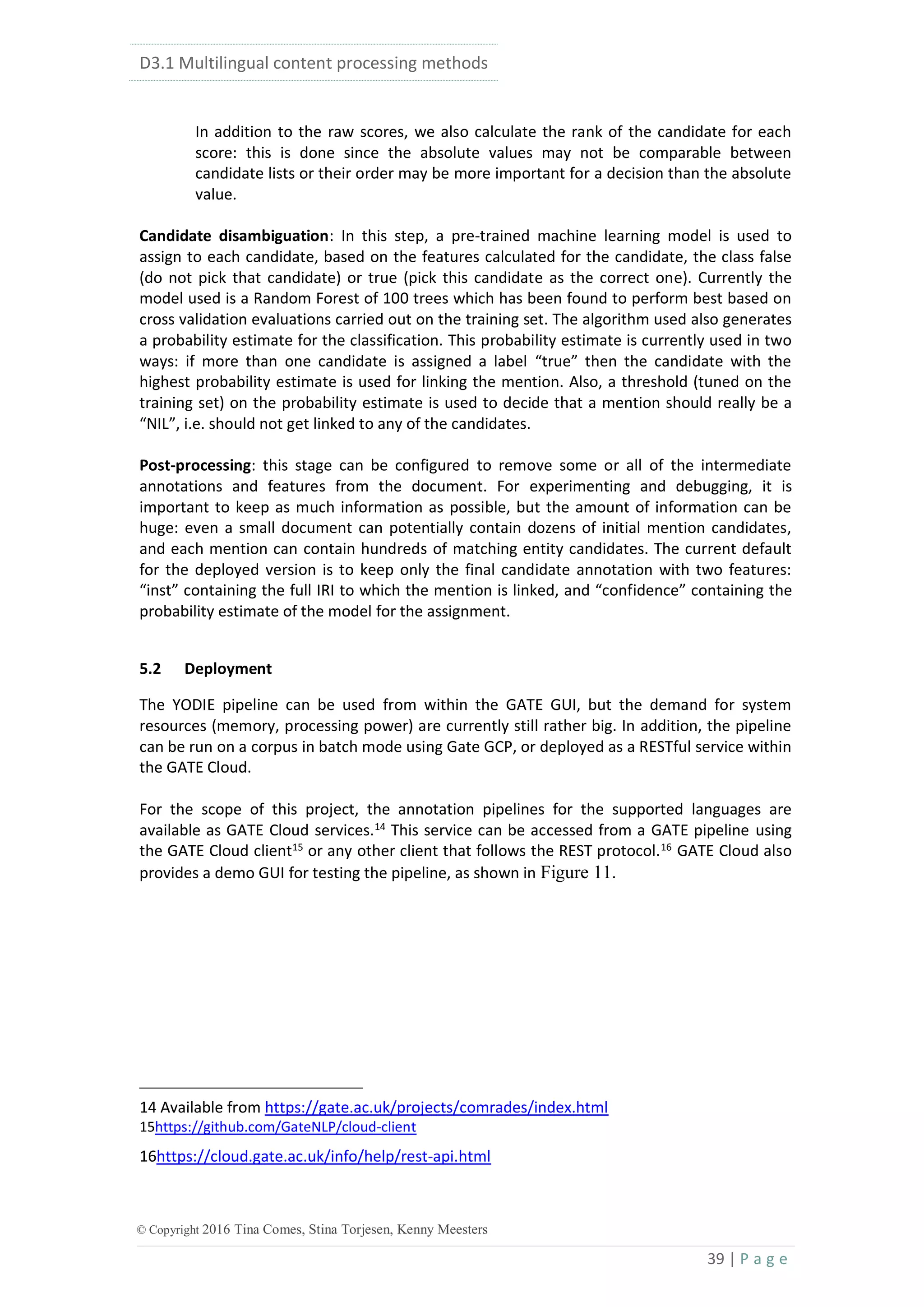
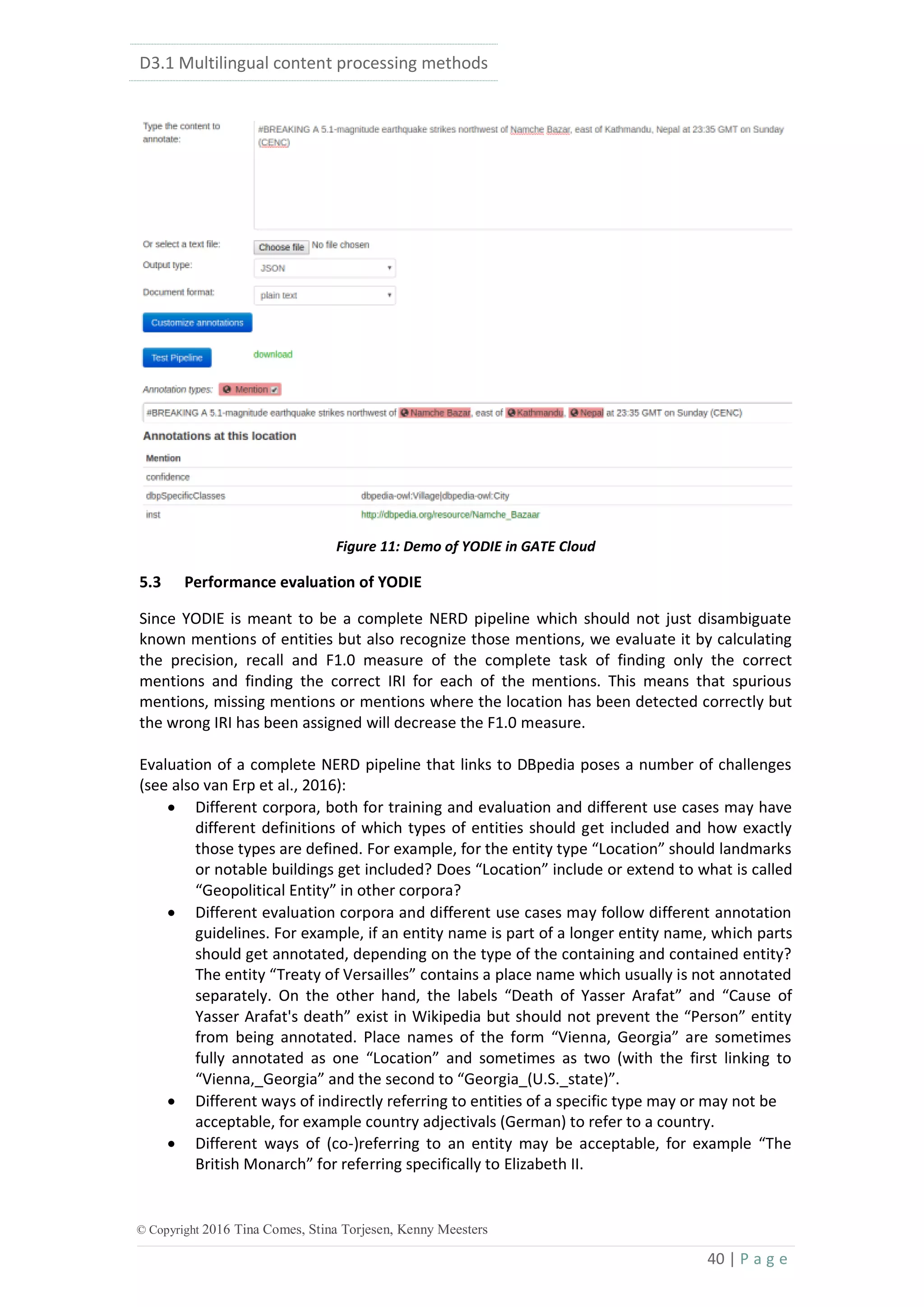
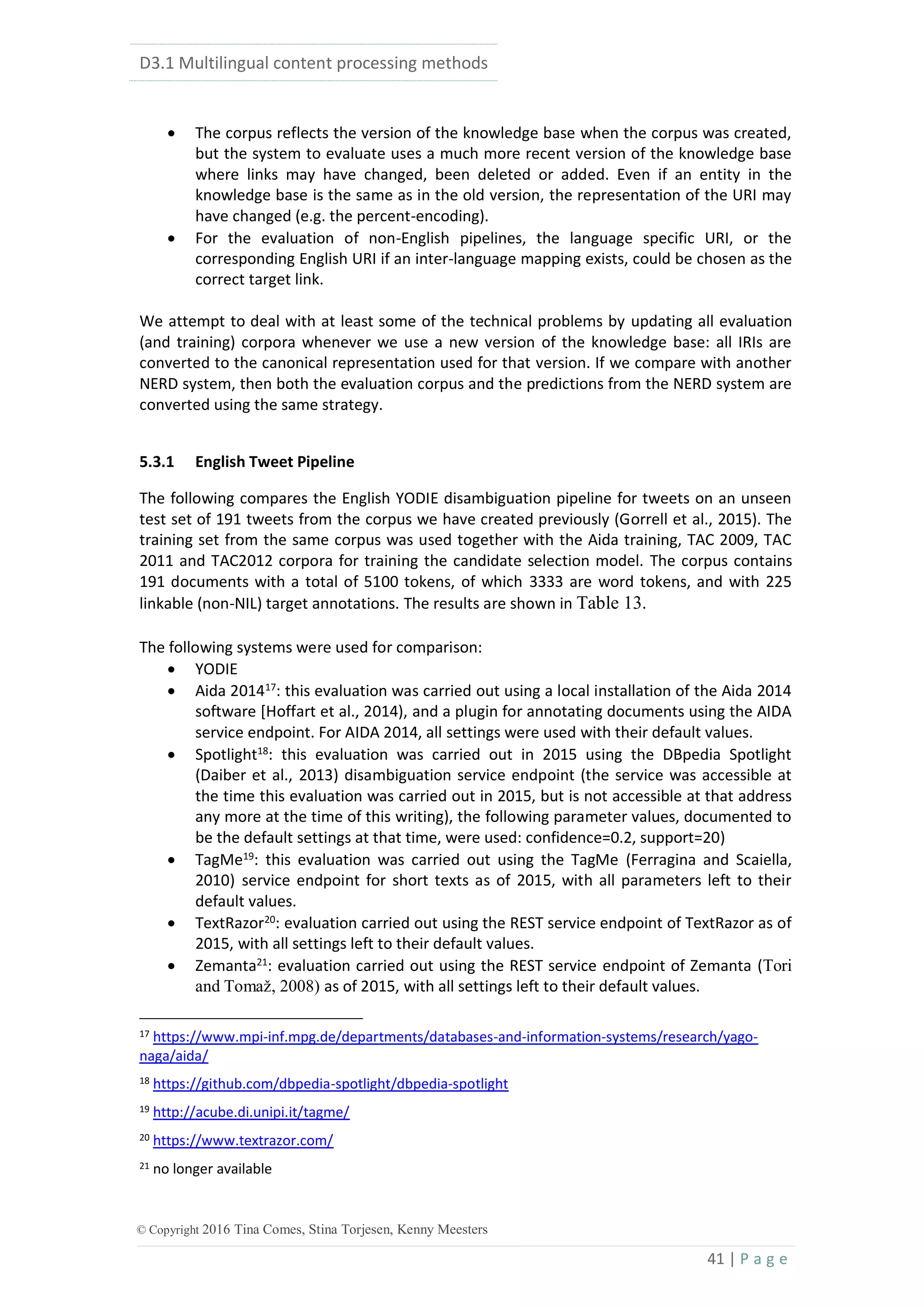
![D3.1 Multilingual content processing methods
42 | P a g e
© Copyright 2016 Tina Comes, Stina Torjesen, Kenny Meesters
System Precision Recall F1.0
YODIE 0.50 0.61 0.55
Aida 2014 0.59 0.38 0.46
Spotlight 0.09 0.51 0.15
TagMe 0.10 0.67 0.17
TextRazor 0.19 0.44 0.26
Zemanta 0.48 0.56 0.52
Table 13: Comparison of different NED systems on an English Twitter Corpus
Note that we expect some further improvements in the performance of YODIE in the coming
months. This is due to two reasons. First, we have detected some target annotations in the
gold standard corpus which are not quite correct and need to be fixed. Second, the model is
trained on the previous release of DBpedia, while the application itself uses the newer
version, so the features are slightly different. We plan to retrain the model on the latest
release of DBpedia.
5.3.2 French YODIE Pipeline
The French YODIE pipeline uses all the language-independent modules and settings of the
English pipeline. The gazetteers, graphs, candidate databases and other language-specific
resources have been created from the French DBpedia files in the preparation phase. Since
there were no French training corpora available, we also use the machine learning model for
candidate selection which was trained on the English training corpora. The preprocessing
stage uses the resources created for the French TwitIE pipeline as described in Section 3.
For evaluation, a corpus with 385 French tweets was used, as described in Section 3. This
corpus was created from an original selection of 1000 French tweets, from which all re-tweets
have been removed. The corpus was first automatically annotated to find named entities of
type Person, Organization and Location; then the documents were manually checked and
corrected. The corpus with the corrected named entity annotations was then pre-annotated
with a sorted list of linking candidates using a modified YODIE pipeline. The pre-annotated
corpus was then again manually checked using the SimpleManualAnnotator tool.22
The result
of the manual correction was then manually checked by another person and automatically
updated to conform to the format needed for evaluation and to canonicalize any links which
were manually modified. The final corpus contains 385 documents, of which 170 do not
contain any linked named entities, and a total of 393 linked named entities.
Table [XXX] shows the result of evaluating the French YODIE pipeline on this corpus without
any language-specific tuning or training. This is a surprisingly good result: the machine
learning model for candidate selection generalizes rather well to this specific corpus. This is
not likely to generalize equally well to other kinds of tweets, however, and future work will
tune some parts of the YODIE pipeline in a language-specific way based on using the French
Wikipedia articles as a silver standard training corpus (see future work).
22 https://github.com/GateNLP/gate-SimpleManualAnnotator](https://image.slidesharecdn.com/d3-171124135548/75/D3-1-Multilingual-content-processing-methods-42-2048.jpg)
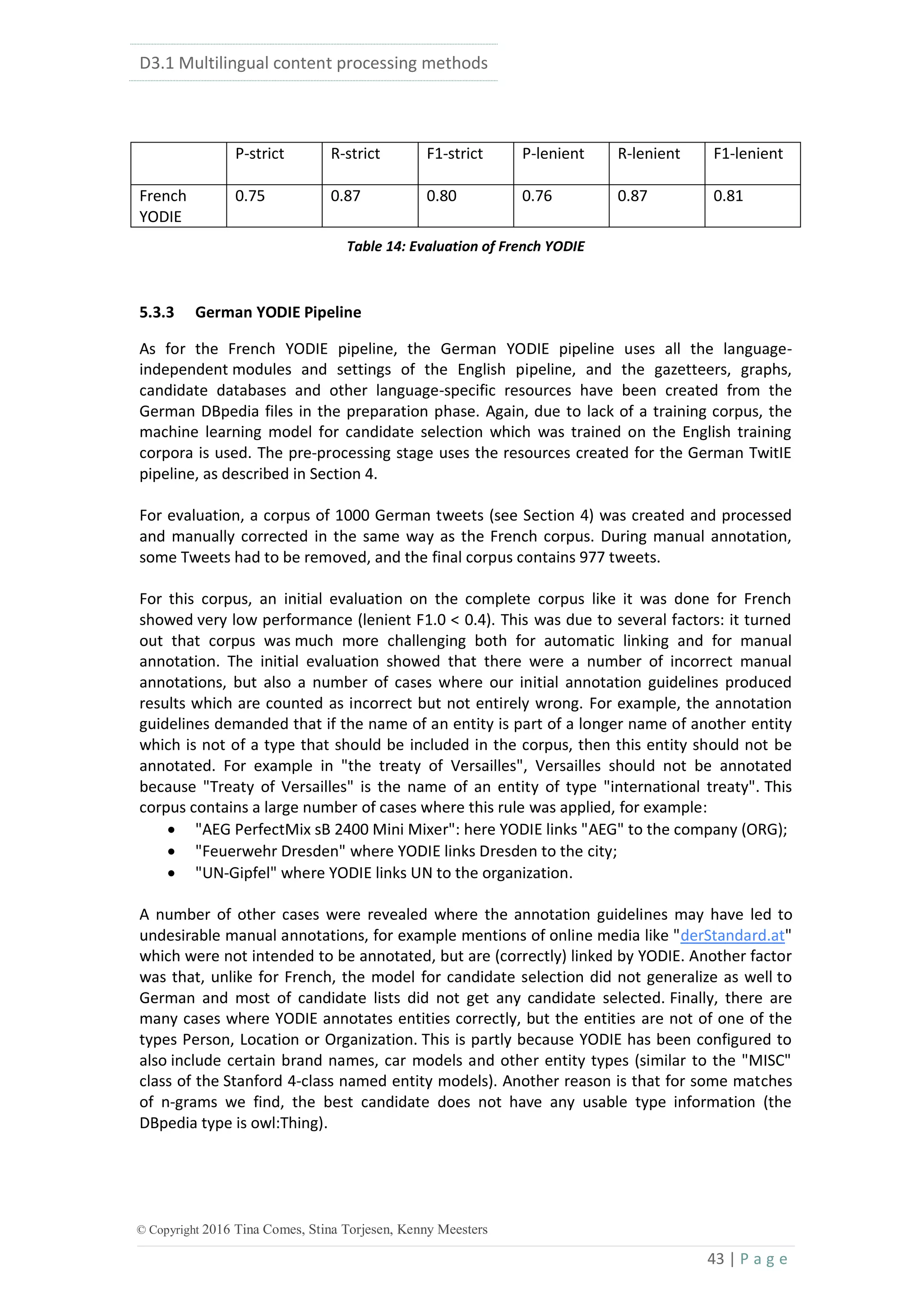

![D3.1 Multilingual content processing methods
45 | P a g e
© Copyright 2016 Tina Comes, Stina Torjesen, Kenny Meesters
information. This is used e.g. to create the annotations that represent linking
candidates in YODIE.
In addition, we are planning to release both the YODIE preparation software and the YODIE
annotation pipeline as open source software. However, this is currently not possible due to
licensing issues: both components use software from the Mallet project (currently licensed
under CPL) and from the Stanford CoreNLP project (licensed under GPL3) which have licenses
that cannot be combined for distribution. However, it is planned that Mallet will change its
license to one that is compatible with GPL, at which point we will be able to make YODIE
available under a compatible license. A variation of YODIE for processing bio-medical texts,
Bio-YODIE has already been released as open source software.28
6 Summary
In this deliverable, we have described the tools developed in GATE for analysing social media
text in English, French and German. This includes tools for linguistic pre-processing, named
entity recognition, and disambiguation/linking of named entities. The tools have been
adapted specifically to work on social media such as tweets, which is a challenging genre due
to the noisy nature of the text (incorrect spelling, punctuation, capitalization etc). The English
system is more fully-fledged, since English will be the primary language of the datasets used
in the project. However, the adaptation to English and German demonstrates the flexibility of
our approach and tools, and shows how they can be modified for new languages. In the
course of this adaptation work, we have faced new research challenges, such as integrating
new 3rd
party components and making them compatible with our existing tools, and adapting
other components to the complexities of different language structures. Evaluation results are
promising, but the tools will continue to be developed through the course of the project
nevertheless.
7 References
[1] K. Bontcheva, L. Derczynski, A. Funk, M.A. Greenwood, D. Maynard, N. Aswani. TwitIE: An
Open-Source Information Extraction Pipeline for Microblog Text. Proceedings of the
International Conference on Recent Advances in Natural Language Processing (RANLP
2013).
[2] S. Carter, W. Weerkamp, and E. Tsagkias. 2013. Microblog language identification:
Overcoming the limitations of short, unedited and idiomatic text. Language Resources
and Evaluation Journal.
[3] B. Crabbé and M. Candito. 2008. Expériences d’analyse syntaxique statistique du français.
In Proc. of TALN’08, pages 45–54, Senlis, France.
[4] W. Cavnar and J. Trenkle. 1994. N-gram-based text categorization. In Proceedings of the
Annual Symposium on Document Analysis and Information Retrieval, pages 161–175.
[5] J. Daiber, M. Jakob, C. Hokamp and P.N. Mendes. Improving Efficiency and Accuracy in
Multilingual Entity Extraction Proceedings of the 9th International Conference on
Semantic Systems, ACM, 2013, 121-124
[6] L. Derczynski, D. Maynard, N. Aswani, and K. Bontcheva. 2013a. Microblog-Genre Noise
and Impact on Semantic Annotation Accuracy. In Proceedings of the 24th ACM Conference
on Hypertext and Social Media. ACM.
28https://gate.ac.uk/applications/bio-yodie.html](https://image.slidesharecdn.com/d3-171124135548/75/D3-1-Multilingual-content-processing-methods-45-2048.jpg)
![D3.1 Multilingual content processing methods
46 | P a g e
© Copyright 2016 Tina Comes, Stina Torjesen, Kenny Meesters
[7] L. Derczynski, A. Ritter, S. Clark, K. Bontcheva. 2013b. Twitter Part-of-Speech Tagging for
All: Overcoming Sparse and Noisy Data. In Proceedings of the International Conference on
Recent Advances in Natural Language Processing (RANLP 2013).
[8] L. Derczynski, D. Maynard, G. Rizzo, M. van Erp, G. Gorrell, R. Troncy, J. Petrak, K.
Bontcheva. Analysis of Named Entity Recognition and Linking for Tweets. In Information
Processing and Management, 51(2) 32-49, 2015.
[9] L. Derczynski and S. Chester, 2016. Generalised Brown Clustering and Roll-Up Feature
Generation. In Proceedings of the Association for Advancement of Artificial Intelligence,
2016.
[10] M. Drouin and C. Davis, 2009. R u txting? Is the use of text speak hurting your literacy?.
Journal of Literacy Research, 41(1), pp.46-67.
[11] P. Ferragina and U. Scaiella. TAGME: On-the-fly Annotation of Short Text Fragments (by
Wikipedia Entities) Proceedings of the 19th ACM International Conference on Information
and Knowledge Management, ACM, 2010, 1625-1628
[12] J. R. Finkel, T. Grenager and C. Manning, "Incorporating non-local Information into
Information Extraction Systems by Gibbs Sampling," in Proceedings of the 43rd Annual
Meeting of the Association for Computational Linguistics (ACL), 2005.
[13] G. Gorrell, J. Petrak and K. Boncheva. Using @twitter Conventions to #enrich Content for
Named Entity Disambiguation, 2015
[14] S. Green, M.C. de Marneffe and C.D. Manning, 2013. Parsing models for identifying
multiword expressions. Computational Linguistics, 39(1), pp.195-227.
[15] K. Greenfield, R. Caceres, M. Coury, K. Geyer, Y. Gwon, J. Matterer, A. Mensch, C. Sahin,
and O. Simek. "A reverse approach to named entity extraction and linking”. In
#Microposts (2016): 67-69.
[16] M. Halliday, C.M. Matthiessen, and C. Matthiessen, 2014. An introduction to functional
grammar. Routledge.
[17] B. Han, P. Cook, and T. Baldwin. 2012. Automatically constructing a normalisation
dictionary for microblogs. In Proceedings of the conference on Em- pirical Methods in
Natural Language Processing, pages 421–432. ACL.
[18] J. Hoffart, M.A. Yosef, I. Bordino, H, Fürstenau, M. Pinkal, M. Spaniol, B. Taneva, S. Thater
and G. Weikum. Robust Disambiguation of Named Entities in Text Proceedings of the
Conference on Empirical Methods in Natural Language Processing, Association for
Computational Linguistics, 2011, 782-792
[19] J. Lehmann, R. Isele, M. Jakob, A. Jentzsch, D. Kontokostas, P.N. Mendes, S. Hellmann,
M. Morsey, P. van Kleef, S. Auer and C. Bizer. DBpedia - A Large-scale, Multilingual
Knowledge Base Extracted from Wikipedia Semantic Web Journal, 2012
[20] M. Lui and T. Baldwin, 2011. Cross-domain feature selection for language identification.
In In Proceedings of 5th International Joint Conference on Natural Language Processing.
[21] M. Lui and T. Baldwin, 2012, July. langid.py: An off-the-shelf language identification tool.
In Proceedings of the ACL 2012 system demonstrations (pp. 25-30). Association for
Computational Linguistics.
[22] J. Nivre, J., M.C. de Marneffe, F. Ginter, Y. Goldberg, J. Hajic, C. D. Manning, R. Tsarfaty,
2016. Universal Dependencies v1: A Multilingual Treebank Collection. In Proceedings of
the Conference on Language Resources and Evaluation, 2016.
[23] O. Owoputi, B. O'Connor, C. Dyer, K. Gimpel, N. Schneider, N.A. Smith, 2013. Improved
part-of-speech tagging for online conversational text with word clusters. In Proceedings
of the conference of the North American Association for Computational Linguistics, 2013.
[24] S. Petrov, D. Das, R. McDonald, 2011. A universal part-of-speech tagset. ArXiv preprint](https://image.slidesharecdn.com/d3-171124135548/75/D3-1-Multilingual-content-processing-methods-46-2048.jpg)
![D3.1 Multilingual content processing methods
47 | P a g e
© Copyright 2016 Tina Comes, Stina Torjesen, Kenny Meesters
arXiv:1104.2086, 2011.
[25] F. Piccinno and P. Ferragina. From TagME to WAT: A New Entity Annotator Proceedings
of the First International Workshop on Entity Recognition &38; Disambiguation, ACM,
2014, 55-62
[26] B. Plank, A. Søgaard and Y, Goldberg, 2016. Multilingual Part-of-Speech Tagging with
Bidirectional Long Short-Term Memory Models and Auxiliary Loss. arXiv preprint
arXiv:1604.05529.
[27] A. Ritter, S. Clark, S. Mausam and O. Etzioni, "Named Entity Recognition in Tweets: An
Experimental Study," in EMNLP, 2011.
[28] R. Sproat, A. Black, S. Chen, S. Kumar, M. Ostendorf, and C. Richards. 2001. Normalization
of non-standard words. Computer Speech & Language, 15(3):287–333.
[29] A. Tori and S. Tomaž "Zemanta service."
https://web.archive.org/web/20140215095047/http://developer.zemanta.com/docs/Ze
manta_API_companion/
[30] R. Usbeck, A.-C. Ngonga Ngomo, S. Auer, D. Gerber and A. Both. AGDISTIS - Graph-Based
Disambiguation of Named Entities using Linked Data International Semantic Web
Conference, 2014
[31] M. van Erp, P.N. Mendes, H. Paulheim, F. Ilievski, J. Plu, G. Rizzo and J. Waitelonis, 2016.
Evaluating Entity Linking: An Analysis of Current Benchmark Datasets and a Roadmap for
Doing a Better Job Proceedings of Language Resources and Evaluation Conference (LREC
2016).
[32] A. Zubiaga and H. Ji. "Tweet, but verify: epistemic study of information verification on
twitter." Social Network Analysis and Mining 4.1 (2014): 1-12.](https://image.slidesharecdn.com/d3-171124135548/75/D3-1-Multilingual-content-processing-methods-47-2048.jpg)